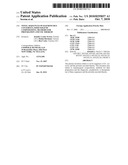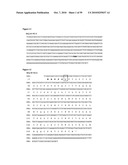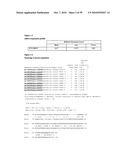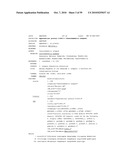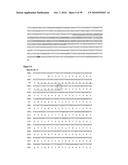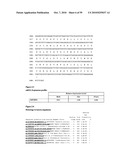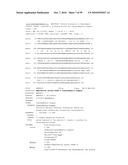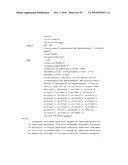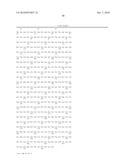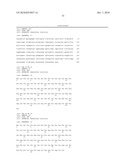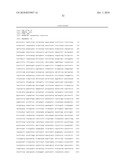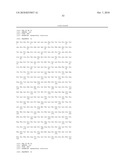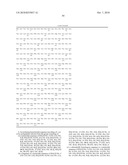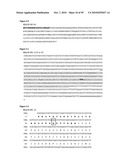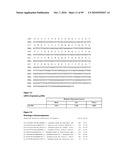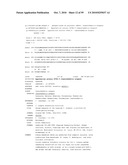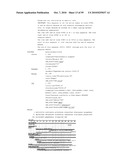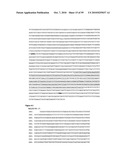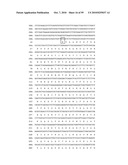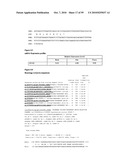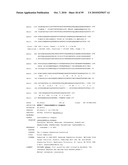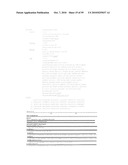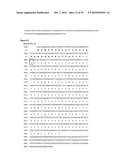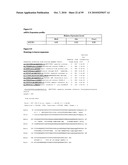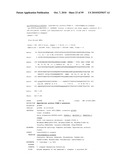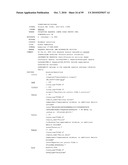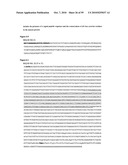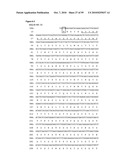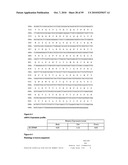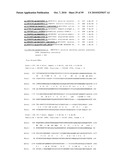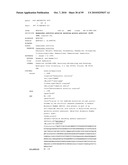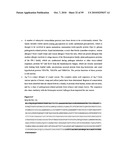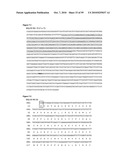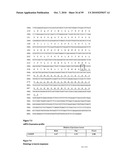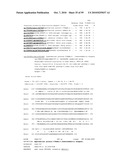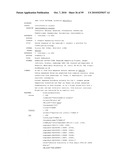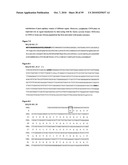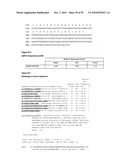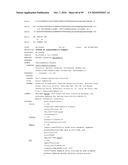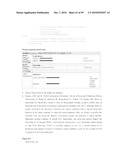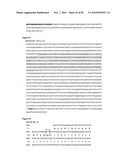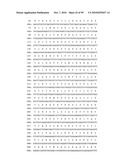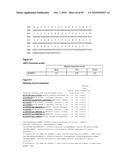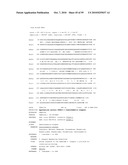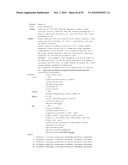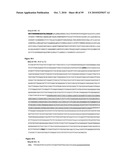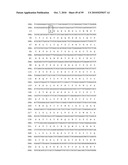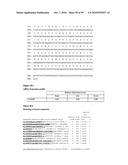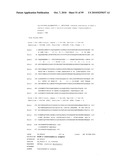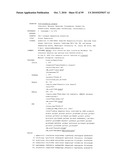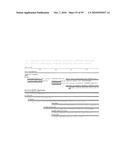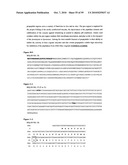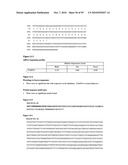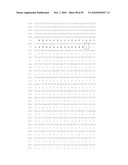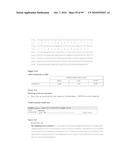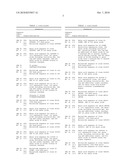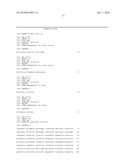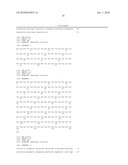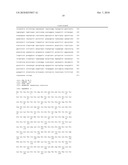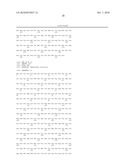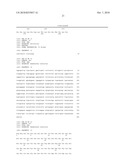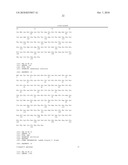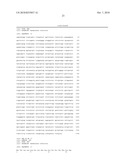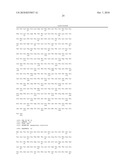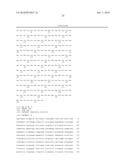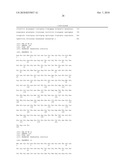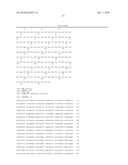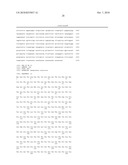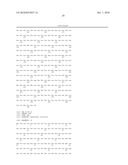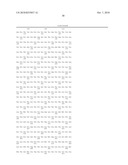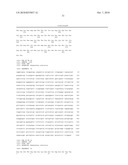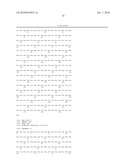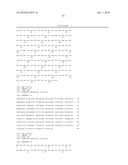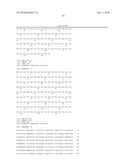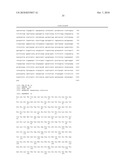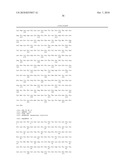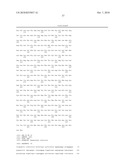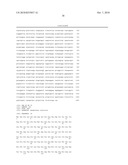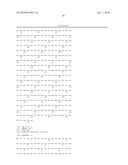Patent application title: NOVEL SEQUENCES OF HAEMONCHUS CONTORTUS, IMMUNOGENIC COMPOSITIONS, METHODS FOR PREPARATION AND USE THEREOF
Inventors:
Jennifer Louise Sexton (Victoria, AU)
Dadna Hartman (Victoria, AU)
Ben Cocks (Victoria, AU)
IPC8 Class: AA61K3900FI
USPC Class:
4242651
Class name: Drug, bio-affecting and body treating compositions antigen, epitope, or other immunospecific immunoeffector (e.g., immunospecific vaccine, immunospecific stimulator of cell-mediated immunity, immunospecific tolerogen, immunospecific immunosuppressor, etc.) parasitic organism or component thereof or substance produced by said parasitic organism (e.g., schistosoma, dirofilaria, trichinella, fasciola, ancylostoma, ascaris, etc.)
Publication date: 2010-10-07
Patent application number: 20100255037
Claims:
1. An isolated polynucleotide sequence encoding a H. contortus polypeptide
selected from the group consisting of:(a) a nucleotide sequence of SEQ ID
No. 5 (FIG. 1-1, FIG. 1-2), SEQ ID No. 8 (FIG. 2-1, FIG. 2-2), SEQ ID No.
12 (FIG. 3-1, FIG. 3-2), SEQ ID No. 16 (FIG. 4-1, FIG. 4-2), SEQ ID No.
19 (FIG. 5-1, FIG. 5-2), SEQ ID No. 22 (FIG. 6-1, FIG. 6-2), SEQ ID No.
25 (FIG. 7-1, FIG. 7-2), SEQ ID No. 28 (FIG. 8-1, FIG. 8-2), SEQ ID No.
31 (FIG. 9-1, FIG. 9-2), SEQ ID No. 34 (FIG. 10-1, FIG. 10-2), SEQ ID No.
37 (FIG. 11-1, FIG. 11-2), SEQ ID No. 40 (FIG. 12-1, FIG. 12-2);(b) a
fragment of a nucleotide sequence of SEQ ID No. 5 (FIG. 1-1, FIG. 1-2),
SEQ ID No. 8 (FIG. 2-1, FIG. 2-2), SEQ ID No. 12 (FIG. 3-1, FIG. 3-2),
SEQ ID No. 16 (FIG. 4-1, FIG. 4-2), SEQ ID No. 19 (FIG. 5-1, FIG. 5-2),
SEQ ID No. 22 (FIG. 6-1, FIG. 6-2), SEQ ID No. 25 (FIG. 7-1, FIG. 7-2),
SEQ ID No. 28 (FIG. 8-1, FIG. 8-2), SEQ ID No. 31 (FIG. 9-1, FIG. 9-2),
SEQ ID No. 34 (FIG. 10-1, FIG. 10-2), SEQ ID No. 37 (FIG. 11-1, FIG.
11-2), SEQ ID No. 40 (FIG. 12-1, FIG. 12-2); or(c) a substantially
homologous sequence to a nucleotide sequence of SEQ ID No. 5 (FIG. 1-1,
FIG. 1-2), SEQ ID No. 8 (FIG. 2-1, FIG. 2-2), SEQ ID No. 12 (FIG. 3-1,
FIG. 3-2), SEQ ID No. 16 (FIG. 4-1, FIG. 4-2), SEQ ID No. 19 (FIG. 5-1,
FIG. 5-2), SEQ ID No. 22 (FIG. 6-1, FIG. 6-2), SEQ ID No. 25 (FIG. 7-1,
FIG. 7-2), SEQ ID No. 28 (FIG. 8-1, FIG. 8-2), SEQ ID No. 31 (FIG. 9-1,
FIG. 9-2), SEQ ID No. 34 (FIG. 10-1, FIG. 10-2), SEQ ID No. 37 (FIG.
11-1, FIG. 11-2), SEQ ID No. 40 (FIG. 12-1, FIG. 12-2).
2. An isolation polynucleotide sequence according to claim 1 wherein said sequence is selected from the group consisting of: the open reading frame (ORF) of nucleotide sequence of SEQ ID No. 5 (FIG. 1-1, FIG. 1-2), SEQ ID No. 8 (FIG. 2-1, FIG. 2-2), SEQ ID No. 12 (FIG. 3-1, FIG. 3-2), SEQ ID No. 16 (FIG. 4-1, FIG. 4-2), SEQ ID No. 19 (FIG. 5-1, FIG. 5-2), SEQ ID No. 22 (FIG. 6-1, FIG. 6-2), SEQ ID No. 25 (FIG. 7-1, FIG. 7-2), SEQ ID No. 28 (FIG. 8-1, FIG. 8-2), SEQ ID No. 31 (FIG. 9-1, FIG. 9-2), SEQ ID No. 34 (FIG. 10-1, FIG. 10-2), SEQ ID No. 37 (FIG. 11-1, FIG. 11-2), SEQ ID No. 40 (FIG. 12-1, FIG. 12-2).
3. An isolated polynucleotide sequence according to claim 1 or claim 2 wherein said sequence at least 80% homologous, preferably 90%, more preferably 95% or most preferably 99% homology to the sequences of claim 1 or claim 2.
4. An isolated polynucleotide sequence which hybridizes under high stringency conditions to an isolated sequence of any one of claims 1-3.
5. An isolated polypeptide sequence of H. contortus comprising the amino acid sequence selected from the group of:(a) SEQ ID No. 6 (FIG. 1-2), SEQ ID No. 7 (FIG. 1-5), SEQ ID No. 9 (FIG. 2-2), SEQ ID No. 10 (FIG. 2-5), SEQ ID No. 13 (FIG. 3-2), SEQ ID No. 14 (FIG. 3-5), SEQ ID No. 17 (FIG. 4-2), SEQ ID No. 18 (FIG. 4-5), SEQ ID No. 20 (FIG. 5-2), SEQ ID No. 21 (FIG. 5-5), SEQ ID No. 23 (FIG. 6-2), SEQ ID No. 24 (FIG. 6-5), SEQ ID No. 26 (FIG. 7-2), SEQ ID No. 27 (FIG. 7-5), SEQ ID No. 29 (FIG. 8-2), SEQ ID No. 30 (FIG. 8-5), SEQ ID No. 32 (FIG. 9-2), SEQ ID No. 33 (FIG. 9-5), SEQ ID No. 35 (FIG. 10-2), SEQ ID No. 36 (FIG. 10-5), SEQ ID No. 38 (FIG. 11-2), SEQ ID No. 39 (FIG. 11-5), SEQ ID No. 41 (FIG. 12-2), SEQ ID No. 42 (FIG. 12-5);(b) a fragment of SEQ ID No. 6 (FIG. 1-2), SEQ ID No. 7 (FIG. 1-5), SEQ ID No. 9 (FIG. 2-2), SEQ ID No. (FIG. 2-5), SEQ ID No. 13 (FIG. 3-2), SEQ ID No. 14 (FIG. 3-5), SEQ ID No. 17 (FIG. 4-2), SEQ ID No. 18 (FIG. 4-5), SEQ ID No. 20 (FIG. 5-2), SEQ ID No. 21 (FIG. 5-5), SEQ ID No. 23 (FIG. 6-2), SEQ ID No. 24 (FIG. 6-5), SEQ ID No. 26 (FIG. 7-2), SEQ ID No. 27 (FIG. 7-5), SEQ ID No. 29 (FIG. 8-2), SEQ ID No. (FIG. 8-5), SEQ ID No. 32 (FIG. 9-2), SEQ ID No. 33 (FIG. 9-5), SEQ ID No. 35 (FIG. 10-2), SEQ ID No. 36 (FIG. 10-5), SEQ ID No. 38 (FIG. 11-2), SEQ ID No. 39 (FIG. 11-5), SEQ ID No. 41 (FIG. 12-2), SEQ ID No. 42 (FIG. 12-5); or(c) a substantially homologous sequence to SEQ ID No. 6 (FIG. 1-2), SEQ ID No. 7 (FIG. 1-5), SEQ ID No. 9 (FIG. 2-2), SEQ ID No. 10 (FIG. 2-5), SEQ ID No. 13 (FIG. 3-2), SEQ ID No. 14 (FIG. 3-5), SEQ ID No. 17 (FIG. 4-2), SEQ ID No. 18 (FIG. 4-5), SEQ ID No. 20 (FIG. 5-2), SEQ ID No. 21 (FIG. 5-5), SEQ ID No. 23 (FIG. 6-2), SEQ ID No. 24 (FIG. 6-5), SEQ ID No. 26 (FIG. 7-2), SEQ ID No. 27 (FIG. 7-5), SEQ ID No. 29 (FIG. 8-2), SEQ ID No. 30 (FIG. 8-5), SEQ ID No. 32 (FIG. 9-2), SEQ ID No. 33 (FIG. 9-5), SEQ ID No. 35 (FIG. 10-2), SEQ ID No. 36 (FIG. 10-5), SEQ ID No. 38 (FIG. 11-2), SEQ ID No. 39 (FIG. 11-5), SEQ ID No. 41 (FIG. 12-2), SEQ ID No. 42 (FIG. 12-5).
6. An isolated polypeptide sequence according to claim 5 wherein said sequence is selected from the group consisting of: SEQ ID No. 7 (FIG. 1-5), SEQ ID No. 10 (FIG. 2-5), SEQ ID No. 14 (FIG. 3-5), SEQ ID No. 18 (FIG. 4-5), SEQ ID No. 21 (FIG. 5-5), SEQ ID No. 24 (FIG. 6-5), SEQ ID No. 27 (FIG. 7-5), SEQ ID No. 30 (FIG. 8-5), SEQ ID No. 33 (FIG. 9-5), SEQ ID No. 36 (FIG. 10-5), SEQ ID No. 39 (FIG. 11-5), SEQ ID No. 42 (FIG. 12-5).
7. An isolated polypeptide sequence according to claim 5 or claim 6 wherein said sequence is at least 80% homologous, preferably 90%, more preferably 95% or most preferably 99% homology to the polypeptide sequences of claim 5 or claim 6.
8. An expression vector comprising a polynucleotide sequence according to any one of claims 1-4 operably linked to a control sequence which is capable of providing for the expression of the polynucleotide sequence by a host cell.
9. A host cell comprising an isolated polypeptide sequence according to any one of claims 5-7.
10. An antibody which binds to a polypeptide sequence according to any one of claims 5-7 encoding a H. contortus protein which is an immunogenic protein.
11. Use of a polypeptide sequence according to any one of claims 5-7 encoding a H. contortus protein for the manufacturing of an immunogenic composition for prophylaxis or treatment of H. contortus infection.
12. An immunogenic composition for the prophylaxis or treatment of H. contortus infection comprising a polypeptide sequence according to any one of claims 5-7 and a pharmaceutically acceptable carrier.
13. An immunogenic composition according to claim 12 further comprising an adjuvant.
14. An immunogenic composition according to claim 12 or claim 13 comprising at least one additional immunogenic sequence derived from another trichostronglyid other than H. contortus.
15. An immunogenic composition according to any one of claims 12-14 comprising antibodies against a protein with a polypeptide sequence according to any one of claims 5-7.
16. Method for the preparation of an immunogenic composition according to any one of claims 12-15 said method comprising the admixing of a protein with a polypeptide sequence according to any one of claims 5-7 and a pharmaceutically acceptable carrier.
17. Method for the preparation of an immunogenic composition according to any one of claims 12-15 said method comprising the admixing of antibodies against a protein with a polypeptide sequence according to any one of claims 6-9 and a pharmaceutically acceptable carrier.
18. Diagnostic kit for the detection of H. contortus disease characterised in that said kit comprises an antibody which bind to a H. contortus protein with a polypeptide sequence according to any one of claims 5-7.
19. Use of a polynucleotide sequence according to any one of claims 1--for the manufacturing of an immunogenic composition for prophylaxis or treatment of H. contortus infection.
20. An immunogenic composition for the prophylaxis or treatment of H. contortus infection comprising a polynucleotide sequence according to any one of claims 1-4 and a pharmaceutically acceptable carrier.
21. An immunogenic composition according to claim 20 further comprising an adjuvant.
22. An immunogenic composition according to claim 20 or claim 21 comprising at least one additional polynucleotide sequence derived from another trichostronglyid other than H. contortus.
23. Method for the preparation of an immunogenic composition according to any one of claims 20-22 said method comprising the admixing a polynucleotide sequence according to any one of claims 1-4 and a pharmaceutically acceptable carrier.
24. Method of prophylaxis or treatment of an animal against H. contortus infection comprising administering a therapeutically effective amount of the immunogenic composition of any one of claims 12-15 or claims 21-23 to said animal.
25. Use of a polypeptide according to any one of claims 5-7 in a method of screening to identify analogous proteins from other helminths, including trematodes, cestodes, nematodes and acathocephala.
Description:
FIELD OF INVENTION
[0001]The present invention relates to novel sequences of Haemonchus contortus and the proteins encoded therein. This invention further relates to immunogenic compositions, methods for their preparation and the diagnostic, prophylactic or therapeutic use of these sequences and the proteins encoded therein.
BACKGROUND OF THE INVENTION
[0002]H. contortus also known as Barber's pole worm, stomach worm or wire worm is a blood-feeding nematode that infects the lining of the gastrointestinal tract and abomasum of ruminant animals. Infection is also possible through the skin. Haemonchus requires no immediate host but may live in soil and water of pastures where the ruminant animals are grazing.
[0003]The economic loss from the effects of reduction in weight, loss of production and agalactia through to death of domestic animals infected by Haemonchus is considerable. In Australia, for example, it is estimated that approximately one third of all sheep are likely to be infected with Haemonchus.
[0004]Anthelmintic chemicals are typically used to treat domestic animals infected by H. contortus but there is an increased frequency of documented resistance to these products. In addition, it is common for an animal to be infected with several species of trichostronglyids at the same time. Therefore, there is a growing need to have alternative ways of preventing and treating animals infested with H. contortus as well as other trichostronglyids.
[0005]The development of a vaccine against H. contortus would overcome many of the drawbacks inherent in chemical treatment. The protection would be longer lasting and the animal could be individually targeted thus avoiding the problems of toxicity associated with chemical treatment.
[0006]Nevertheless, it is particularly difficult to develop vaccines against parasitic helminth infections because of the complexity of the parasite's life cycle. Although vaccine candidates have been reported for H. contortus (see: WO88/00835), there is a need to develop further and more efficacious vaccines, particularly as recombinant vaccines.
SUMMARY OF THE INVENTION
[0007]The invention relates to novel sequences of H. contortus and proteins which are encoded by those sequences. It further relates to the use of these sequences and proteins of the invention for diagnostic, prophylactic or therapeutic purposes.
[0008]In one aspect of the invention, isolated polynucleotide sequences encoding a H. contortus polypeptide are provided with nucleotide sequence of: SEQ ID No. 5 (FIG. 1-1, FIG. 1-2), SEQ ID No. 8 (FIG. 2-1, FIG. 2-2), SEQ ID No. 12 (FIG. 3-1, FIG. 3-2), SEQ ID No. 16 (FIG. 4-1, FIG. 4-2), SEQ ID No. 19 (FIG. 5-1, FIG. 5-2), SEQ ID No. 22 (FIG. 6-1, FIG. 6-2), SEQ ID No. 25 (FIG. 7-1, FIG. 7-2), SEQ ID No. 28 (FIG. 8-1, FIG. 8-2), SEQ ID No. 31 (FIG. 9-1, FIG. 9-2), SEQ ID No. 34 (FIG. 10-1, FIG. 10-2), SEQ ID No. 37 (FIG. 11-1, FIG. 11-2), SEQ ID No. 40 (FIG. 12-1, FIG. 12-2).
[0009]In another aspect of the invention, isolated polynucleotide sequences which are fragments of SEQ ID No. 5 (FIG. 1-1, FIG. 1-2), SEQ ID No. 8 (FIG. 2-1, FIG. 2-2), SEQ ID No. 12 (FIG. 3-1, FIG. 3-2), SEQ ID No. 16 (FIG. 4-1, FIG. 4-2), SEQ ID No. 19 (FIG. 5-1, FIG. 5-2), SEQ ID No. 22 (FIG. 6-1, FIG. 6-2), SEQ ID No. (FIG. 7-1, FIG. 7-2), SEQ ID No. 28 (FIG. 8-1, FIG. 8-2), SEQ ID No. 31 (FIG. 9-1, FIG. 9-2), SEQ ID No. 34 (FIG. 10-1, FIG. 10-2), SEQ ID No. 37 (FIG. 11-1, FIG. 11-2), SEQ ID No. 40 (FIG. 12-1, FIG. 12-2) are provided.
[0010]In a further aspect of the invention, homologous polynucleotide sequences which are at least 80% homologous, preferably 90%, more preferably 95% and most preferably 99% homology to the sequences of SEQ ID No. 5 (FIG. 1-1, FIG. 1-2), SEQ ID No. 8 (FIG. 2-1, FIG. 2-2), SEQ ID No. 12 (FIG. 3-1, FIG. 3-2), SEQ ID No. 16 (FIG. 4-1, FIG. 4-2), SEQ ID No. 19 (FIG. 5-1, FIG. 5-2), SEQ ID No. 22 (FIG. 6-1, FIG. 6-2), SEQ ID No. 25 (FIG. 7-1, FIG. 7-2), SEQ ID No. 28 (FIG. 8-1, FIG. 8-2), SEQ ID No. 31 (FIG. 9-1, FIG. 9-2), SEQ ID No. 34 (FIG. 10-1, FIG. 10-2), SEQ ID No. 37 (FIG. 11-1, FIG. 11-2), SEQ ID No. 40 (FIG. 12-1, FIG. 12-2) are provided.
[0011]In yet another aspect of the invention, polynucleotide sequences which hybridize under high stringency conditions to an isolated sequence of SEQ ID No. 5 (FIG. 1-1, FIG. 1-2), SEQ ID No. 8 (FIG. 2-1, FIG. 2-2), SEQ ID No. 12 (FIG. 3-1, FIG. 3-2), SEQ ID No. 16 (FIG. 4-1, FIG. 4-2), SEQ ID No. 19 (FIG. 5-1, FIG. 5-2), SEQ ID No. 22 (FIG. 6-1, FIG. 6-2), SEQ ID No. 25 (FIG. 7-1, FIG. 7-2), SEQ ID No. 28 (FIG. 8-1, FIG. 8-2), SEQ ID No. 31 (FIG. 9-1, FIG. 9-2), SEQ ID No. 34 (FIG. 10-1, FIG. 10-2), SEQ ID No. 37 (FIG. 11-1, FIG. 11-2), SEQ ID No. 40 (FIG. 12-1, FIG. 12-2) are provided.
[0012]In a second aspect of the invention, polypeptide sequences of H. contortus are provided: SEQ ID No. 6 (FIG. 1-2), SEQ ID No. 7 (FIG. 1-5), SEQ ID No. 9 (FIG. 2-2), SEQ ID No. 10 (FIG. 2-5), SEQ ID No. 13 (FIG. 3-2), SEQ ID No. 14 (FIG. 3-5), SEQ ID No. 17 (FIG. 4-2), SEQ ID No. 18 (FIG. 4-5), SEQ ID No. 20 (FIG. 5-2), SEQ ID No. 21 (FIG. 5-5), SEQ ID No. 23 (FIG. 6-2), SEQ ID No. 24 (FIG. 6-5), SEQ ID No. 26 (FIG. 7-2), SEQ ID No. 27 (FIG. 7-5), SEQ ID No. 29 (FIG. 8-2), SEQ ID No. 30 (FIG. 8-5), SEQ ID No. 32 (FIG. 9-2), SEQ ID No. 33 (FIG. 9-5), SEQ ID No. 35 (FIG. 10-2), SEQ ID No. 36 (FIG. 10-5), SEQ ID No. 38 (FIG. 11-2), SEQ ID No. 39 (FIG. 11-5), SEQ ID No. 41 (FIG. 12-2), SEQ ID No. 42 (FIG. 12-5).
[0013]In one aspect of the invention, fragments of polypeptide sequences SEQ ID No. 6 (FIG. 1-2), SEQ ID No. 7 (FIG. 1-5), SEQ ID No. 9 (FIG. 2-2), SEQ ID No. 10 (FIG. 2-5), SEQ ID No. 13 (FIG. 3-2), SEQ ID No. 14 (FIG. 3-5), SEQ ID No. 17 (FIG. 4-2), SEQ ID No. 18 (FIG. 4-5), SEQ ID No. 20 (FIG. 5-2), SEQ ID No. 21 (FIG. 5-5), SEQ ID No. 23 (FIG. 6-2), SEQ ID No. 24 (FIG. 6-5), SEQ ID No. 26 (FIG. 7-2), SEQ ID No. 27 (FIG. 7-5), SEQ ID No. 29 (FIG. 8-2), SEQ ID No. 30 (FIG. 8-5), SEQ ID No. 32 (FIG. 9-2), SEQ ID No. 33 (FIG. 9-5), SEQ ID No. 35 (FIG. 10-2), SEQ ID No. 36 (FIG. 10-5), SEQ ID No. 38 (FIG. 11-2), SEQ ID No. 39 (FIG. 11-5), SEQ ID No. 41 (FIG. 12-2), SEQ ID No. 42 (FIG. 12-5) are provided.
[0014]In another aspect of the invention, homologous polypeptides sequences are provided wherein said sequence is at least 80% homologous, preferably 90%, more preferably 95% and most preferably 99% homology to SEQ ID No. 6 (FIG. 1-2), SEQ ID No. 7 (FIG. 1-5), SEQ ID No. 9 (FIG. 2-2), SEQ ID No. (FIG. 2-5), SEQ ID No. 13 (FIG. 3-2), SEQ ID No. 14 (FIG. 3-5), SEQ ID No. 17 (FIG. 4-2), SEQ ID No. 18 (FIG. 4-5), SEQ ID No. 20 (FIG. 5-2), SEQ ID No. 21 (FIG. 5-5), SEQ ID No. 23 (FIG. 6-2), SEQ ID No. 24 (FIG. 6-5), SEQ ID No. 26 (FIG. 7-2), SEQ ID No. 27 (FIG. 7-5), SEQ ID No. 29 (FIG. 8-2), SEQ ID No. (FIG. 8-5), SEQ ID No. 32 (FIG. 9-2), SEQ ID No. 33 (FIG. 9-5), SEQ ID No. 35 (FIG. 10-2), SEQ ID No. 36 (FIG. 10-5), SEQ ID No. 38 (FIG. 11-2), SEQ ID No. 39 (FIG. 11-5), SEQ ID No. 41 (FIG. 12-2), SEQ ID No. 42 (FIG. 12-5).
[0015]In a third aspect of the invention, expression vectors are provided, comprising a polynucleotide sequence of the invention operably linked to a control sequence which is capable of providing for the expression of the polynucleotide sequence by a host cell.
[0016]In a fourth of the invention, host cells are provided comprising a polypeptide sequence of the invention.
[0017]In a fifth aspect of the invention, an antibody which binds to a protein which has a polypeptide sequence of the invention is provided.
[0018]In a sixth aspect of the invention, the use of a polypeptide sequence of the invention encoding a H. contortus protein for the manufacturing of an immunogenic composition for prophylaxis or treatment of H. contortus infection is provided.
[0019]In a seventh aspect of the invention, an immunogenic composition for the prophylaxis or treatment of H. contortus infection comprising a polypeptide sequence of the invention encoding a H. contortus protein is provided.
[0020]In an eighth aspect of the invention, an immunogenic composition comprising at least one additional immunogenic sequence derived from another trichostrongylidae other than Haemonchus is provided.
[0021]In a ninth aspect of the invention, methods for the preparation of an immunogenic composition of the invention are provided.
[0022]In a tenth aspect of the invention, a diagnostic kit for the detection of antibodies against H. contortus is provided.
[0023]In one aspect of the invention, the diagnostic kit comprises antibodies against a protein with a polypeptide sequence of the invention from H. contortus.
[0024]In an eleventh aspect of the invention, use of a polynucleotide sequence of the invention for the manufacturing of an immunogenic composition for prophylaxis or treatment of H. contortus infection is provided.
[0025]In a twelfth aspect of the invention, an immunogenic composition for the prophylaxis or treatment of H. contortus infection comprising a polynucleotide sequence of the invention is provided.
[0026]In one aspect, the immunogenic composition comprises at least one additional sequence derived from another trichostronglyid other than H. contortus.
DETAILED DESCRIPTION OF THE INVENTION
[0027]Nucleic acid molecules of the present invention may be in the form of RNA, such as mRNA, or in the form of DNA, including, for instance, cDNA and genomic DNA obtained by cloning or produced synthetically. The DNA may be double-stranded or single-stranded. Single-stranded DNA or RNA may be the coding strand, also known as the sense strand, or it may be the non-coding strand, also referred to as the anti-sense strand.
[0028]By "isolated polynucleotides" what is intended is a nucleic acid molecule, DNA or RNA, which has been removed from its native environment. For example, recombinant DNA molecules contained in a vector are considered isolated for the purposes of the present invention. Further examples of isolated DNA molecules include recombinant DNA molecules maintained in heterologous host cells or purified (partially or substantially) DNA molecules in solution. Isolated RNA molecules include in vivo or in vitro RNA transcripts of the DNA molecules of the present invention. Isolated nucleic acid molecules according to the present invention further include such molecules produced synthetically. It is possible for an isolated polynucleotide to exist but not qualify as a purified polynucleotide.
[0029]In addition, isolated nucleic acid molecules of the invention include DNA molecules which comprise a sequence substantially different from those described above but which, due to the degeneracy of the genetic code, still encode a H. contortus polypeptides and peptides of the present invention. This includes the genetic code and species-specific codon preferences known in the art. Thus, it would be routine for one skilled in the art to generate the degenerate variants described above, for instance, to optimize codon expression for a particular host (e.g., change codons in the bacteria mRNA to those preferred by a mammalian or other bacterial host such as Escherichia coli).
[0030]The invention provides isolated nucleic acid molecules having the nucleotide sequence shown in Table 1 or a nucleic acid molecule having a sequence complementary to one of the above described sequences. Such isolated molecules, particularly DNA molecules, are useful as probes for gene mapping and for identifying H. contortus in a biological sample, for instance, by PCR, Southern blot, Northern blot, or other form of hybridization analysis.
[0031]The present invention is further directed to nucleic acid molecules encoding fragments of the nucleotide sequences described herein. Further, the invention includes polynucleotides comprising fragments specified by size, in nucleotides, rather than by nucleotide positions. Such nucleotide fragments may be useful as diagnostic probes and primers.
TABLE-US-00001 TABLE 1 Sequences Sequence Identi- fier Figure Description SEQ ID His-linker Forward NO. 1 GTCCCACCATCACCATCACCATACCATGGG SEQ ID His-linker Reverse NO. 2 AATTCCCATGGTATGGTGATGGTGATGGTGG SEQ ID T7 Primer NO. 3 GTAATACGACTCACTATAG SEQ ID SP6 Primer NO. 4 ATTTAGGTGACACTATAG SEQ ID FIG. Nucleotide sequence of clone NO. 5 1-1 S7T104D12, 573 base pairs FIG. Nucleotide sequence of clone 1-2 S7T104D12 SEQ ID FIG. Amino acid sequence of clone NO. 6 1-2 S7T104D12, ORF of 144 amino acids SEQ ID FIG. Amino acid sequence for S7T104D12 E. NO. 7 1-5 coli expression clone, 161 amino acids including initiation Met, His tag and linker residues, and 139 amino acids of S7T104D12 without N- terminal residues SEQ ID FIG. Nucleotide sequence of clone NO. 8 2-1 S4T58F9, 977 base pairs FIG. Nucleotide sequence of clone S4T58F9 2-2 SEQ ID FIG. Amino acid sequence of clone NO. 9 2-2 S4T58F9, ORF of 302 amino acids SEQ ID FIG. Amino acid sequence for S4T58F9 E. NO. 10 2-5 coli expression clone, 287 amino acids including initiation Met, His tag and linker residues, and 265 amino acids of S4T58F9 without N- terminal residues SEQ ID T3 primer NO. 11 CAATTAACCCTCACTAAAG SEQ ID FIG. Nucleotide sequence of clone S1-381, NO. 12 3-1 846 base pairs FIG. Nucleotide sequence of clone S1-381 3-2 SEQ ID FIG. Amino acid sequence of clone S1-381, NO. 13 3-2 ORF of 167 amino acids SEQ ID FIG. Amino acid sequence for S1-381 E. NO. 14 3-5 coli expression clone, 168 amino acids including initiation Met, His tag and linker residues, and 146 amino acids of S1-381 without N- terminal residues SEQ ID λTriplex 5' Primer NO. 15 TCCGAGATCTGGACGAGC SEQ ID FIG. Nucleotide sequence of clone G0142, NO. 16 4-1 1788 base pair FIG. Nucleotide sequence of clone G0142 4-2 SEQ ID FIG. Amino acid sequence of clone G0142, NO. 17 4-2 ORF of 290 amino acids SEQ ID FIG. Amino acid sequence for G0142 E. NO. 18 4-5 coli expression clone, 312 amino acids including initiation Met, His tag and linker residues, and 290 amino acids of G0142 SEQ ID FIG. Nucleotide sequence of clone S1T1F1, NO. 19 5-1 881 base pairs FIG. Nucleotide sequence of clone S1T1F1 5-2 SEQ ID FIG. Amino acid sequence of clone S1T1F1, NO. 20 5-2 ORF of 228 amino acids SEQ ID FIG. Amino acid sequence for S1T1F1 E. NO. 21 5-5 coli expression clone, 218 amino acids including initiation Met, His tag and linker residues, and 196 amino acids of S1T1F1 without N- terminal residues SEQ ID FIG. Nucleotide sequence of clone S2- NO. 22 6-1 259MF, 1609 base pair FIG. Nucleotide sequence of clone S2- 6-2 259MF SEQ ID FIG. Amino acid sequence of clone S2- NO. 23 6-2 259MF, ORF of 502 amino acids SEQ ID FIG. Amino acid sequence for S2-259MF NO. 24 6-5 Baculovirus expression clone, 594 amino acids including initiation Met, secretion signal, His tag and an additional 40 amino acids at the C-terminus due to unusual recombi- nation during cloning, and 491 amino acids of S2-259 missing 11 amino acids from C-terminus due to unusual recombination event SEQ ID FIG. Nucleotide sequence of clone G1083P, NO. 25 7-1 1200 base pairs FIG. Nucleotide sequence of clone G1083P 7-2 SEQ ID FIG. Amino acid sequence of clone G1083P, NO. 26 7-2 ORF of 289 amino acids SEQ ID FIG. Amino acid sequence for G1083P E. NO. 27 7-5 coli expression clone, 252 amino acids including initiation Met, His tag and additional linker residues, and 230 amino acids from G1083P minus C-terminal transmembrane domain SEQ ID FIG. Nucleotide sequence of clone dd165- NO. 28 8-1 2NTC#1, 579 base pairs FIG. Nucleotide sequence of clone dd165- 8-2 2NTC#1 SEQ ID FIG. Amino acid sequence of clone dd165- NO. 29 8-2 2NTC#1, ORF of 122 amino acids SEQ ID FIG. Amino acid sequence for dd165-2NTC#1 NO. 30 8-5 E. coli expression clone, 144 amino acids including initiation Met, His tag and additional linker residues, and 122 amino acids of dd165-2NTC#1 SEQ ID FIG. Nucleotide sequence of clone NO. 31 9-1 S4T69C3, 1383 base pairs FIG. Nucleotide sequence of clone S4T69C3 9-2 SEQ ID FIG. Amino acid sequence of clone NO. 32 9-2 S4T69C3, ORF of 434 amino acids SEQ ID FIG. Amino acid sequence for S4T69C3 E. NO. 33 9-5 coli expression clone, 441 amino acids including initiation Met, His tag and additional linker, and 419 amino acids of S4T69C3 minus the signal sequence SEQ ID FIG. Nucleotide sequence of clone YAd189, NO. 34 10-1 approximately 1500 base pairs FIG. Nucleotide sequence of clone YAd189 10-2 SEQ ID FIG. Amino acid sequence of clone YAd189, NO. 35 10-2 ORF of 421 amino acids SEQ ID FIG. Amino acid sequence for YAd189 E. NO. 36 10-5 coli expression clone, 443 amino acids including initiation Met, His tag and additional linker, and 421 amino acids of YAd189 SEQ ID FIG. Nucleotide sequence of clone YAd219, NO. 37 11-1 464 base pairs FIG. Nucleotide sequence of clone YAd219 11-2 SEQ ID FIG. Amino acid sequence of clone YAd219, NO. 38 11-2 ORF of 97 amino acids SEQ ID FIG. Amino acid sequence for YAd219 E. NO. 39 11-5 coli expression clone, 94 amino acids including initiation Met, His tag and additional linker, and 72 amino acid of YAd219 minus the signal sequence SEQ ID FIG. Nucleotide sequence of clone NO. 40 12-1 S4T55C6, 2036 base pairs FIG. Nucleotide sequence of clone S4T55C6 12-2 SEQ ID FIG. Amino acid sequence of clone NO. 41 12-2 S4T55C6, ORF of 320 amino acids SEQ ID FIG. Amino acid sequence for S4T55C6 E. NO. 42 12-5 coli expression clone, 312 amino acids including the initiation Met, His tag and additional linker residues, and 290 amino acids of S4T55C6 minus signal sequence
[0032]In one aspect of the invention, preferred fragments are the open reading frame (ORF) sequences from proteins of H. contortus.
[0033]The sequences which are open reading frame (ORF) sequences encoding proteins of H. contortus are selected from the group consisting of SEQ ID No. 6 (FIG. 1-2), SEQ ID No. 7 (FIG. 1-5), SEQ ID No. 9 (FIG. 2-2), SEQ ID No. 10 (FIG. 2-5), SEQ ID No. 13 (FIG. 3-2), SEQ ID No. 14 (FIG. 3-5), SEQ ID No. 17 (FIG. 4-2), SEQ ID No. 18 (FIG. 4-5), SEQ ID No. 20 (FIG. 5-2), SEQ ID No. 21 (FIG. 5-5), SEQ ID No. 23 (FIG. 6-2), SEQ ID No. 24 (FIG. 6-5), SEQ ID No. 26 (FIG. 7-2), SEQ ID No. 27 (FIG. 7-5), SEQ ID No. 29 (FIG. 8-2), SEQ ID No. 30 (FIG. 8-5), SEQ ID No. 32 (FIG. 9-2), SEQ ID No. 33 (FIG. 9-5), SEQ ID No. 35 (FIG. 10-2), SEQ ID No. 36 (FIG. 10-5), SEQ ID No. 38 (FIG. 11-2), SEQ ID No. 39 (FIG. 11-5), SEQ ID No. 41 (FIG. 12-2), SEQ ID No. 42 (FIG. 12-5)
[0034]In a preferred aspect of the invention such ORFs encode immunogenic polypeptides useful against H. contortus infection.
[0035]By "immunogenic", it is meant that there is a protective effect in the target animal which includes prevention of helminth infection, viability and/or fecundity as well as reduced infection, growth, viability and/or fecundity and also includes various levels of amelioration of symptoms of helminth infection. Even a partial reduction in helminth numbers or ability to spread is useful in controlling helminth infection in animals. The protective effect can also be measured by increased productivity of a group of animals.
[0036]Although a polypeptide representing a complete ORF may be the closest approximation of a protein native to an organism, it is not always preferred to express a complete ORF in a heterologous system. It may be challenging to express and purify a highly hydrophobic protein by common laboratory methods. Some of the immunogenic compositions described herein may be modified slightly to simplify the production of recombinant protein. For example, nucleotide sequences which encode highly hydrophobic domains, such as those found at the amino terminal signal sequence, may be excluded from some constructs used for in vitro expression of the polypeptides. Furthermore, any highly hydrophobic amino acid sequences occurring at the carboxy terminus have also been excluded from the recombinant expression constructs. Thus, in another aspect of the invention, a polypeptide which represents a truncated or modified ORF of the ORFs disclosed above may be used in an immunogenic composition.
[0037]In another aspect, the invention provides isolated nucleic acid molecules comprising polynucleotides which hybridize under stringent hybridization conditions to a portion of a polynucleotide in a nucleic acid molecule of the invention.
[0038]In one aspect of the invention, the polynucleotides hybridize under stringent hybridization conditions to an isolated polynucleotide sequence coding a H. contortus polypeptide of the invention.
[0039]By "stringent hybridization" conditions it is intended overnight incubation at 42 C in a solution comprising: 50% formamide, 5×SSC (150 mM NaCl, 15 mM trisodium citrate), 50 mM sodium phosphate (pH 7; 6), 5×Denhardt's solution, 10% dextran sulfate, and 20 g/m denatured, sheared salmon sperm DNA, followed by washing the filters in 0.1×SSC at about 65 C.
[0040]By polynucleotides which hybridize it is intended that the polynucleotides (either DNA or RNA) which hybridize are at least about 15 nucleotides, and more preferably at least about 20 nucleotides, still more preferably at least about 30 nucleotides, and even more preferably about 30-70 nucleotides of the reference polynucleotide. These are useful as diagnostic probes and primers.
[0041]As noted above, such portions are useful diagnostically either as probes according to conventional DNA hybridization techniques or as primers for amplification of a target sequence by PCR as described, for instance, in Molecular Cloning, A Laboratory Manual, 2nd. edition, Sambrook, J., Fritsch, E. F. and Maniatis, T., eds., Cold Spring Harbor Laboratory Press, Cold Spring Harbor, N.Y. (1989), the entire disclosure of which is hereby incorporated herein by reference. Since nucleic acid sequences encoding the polypeptides of the present invention are provided generating polynucleotides which hybridize to portions of these sequences would be routine to the skilled artisan
[0042]The present invention further relates to "substantially homologous sequences" or "homologous sequences" of the present invention, which encode portions, analogs or derivatives of the H. contortus polypeptides. Such variants include those produced by nucleotide substitutions, deletions or additions. The substitutions, deletions or additions may involve one or more nucleotides. These variants may be altered in coding regions, non-coding regions, or both. Alterations in the coding regions may produce conservative or non-conservative amino acid substitutions, deletions or additions. Especially preferred among these are silent substitutions, additions and deletions, which do not alter the properties and activities of the H. contortus polypeptides disclosed herein or portions thereof. Also especially preferred in this regard are conservative substitutions.
[0043]The present application is further directed to polynucleotides sequences at least 80% homologous to a nucleic acid sequences disclosed herein. Embodiments of the invention comprise a polynucleotide having a nucleotide sequence at least 80% homologous, more preferably at least 90%, and most preferably at least 99% identical to a nucleotide sequence encoding any of the amino acid sequences of the full-length polypeptides and a nucleotide sequence complementary to any of the nucleotide sequences described above and in Table 1 and FIGS. 1 to 12.
[0044]By a polynucleotide having a nucleotide sequence at least, for example, 95% to a reference nucleotide sequence of the present invention, it is intended that the nucleotide sequence of the polynucleotide is identical to the reference sequence except that the polynucleotide sequence may include up to five point mutations per each 100 nucleotides of the reference nucleotide sequence encoding the H. contortus polypeptide.
[0045]In one embodiment of the invention, the isolated polynucleotide sequence is at least 80% homologous, preferably 90% homologous, more preferably 95% and most preferably 99% homologous to the H. contortus sequences described in Table 1 and FIGS. 1 to 12.
[0046]The present invention also relates to expression vectors which include the isolated polynucleotide sequences of the present invention, host cells which are genetically engineered with the recombinant vectors, and the production of H. contortus polypeptides or fragments thereof by recombinant techniques.
[0047]In one aspect of the invention, an expression vector comprising a polynucleotide sequence of the invention as described in Table 1 and FIGS. 1-12 is provided, operably linked to a control sequence which is capable of providing expression of the polynucleotide sequence by a host cell.
[0048]Recombinant constructs may be introduced into host cells using well known techniques such as infection, transduction, transfection transvection, electroporation and transformation. The vector may be for example, a phage, plasmid, viral or retroviral vector. Retroviral vectors may be replication competent or replication defective. In the latter case, viral propagation generally will occur only in complementing host cells.
[0049]The polynucleotides may be joined to a vector containing a selectable marker for propagation in a host. Generally, a plasmid vector is introduced in a precipitate, such as a calcium phosphate precipitate, or in a complex with a charged lipid. If the vector is a virus, it may be packaged in vitro using an appropriate packaging cell line and then transduced into host cells.
[0050]Expression vectors useful in the present invention include chromosomal-, episomal- and virus-derived vectors, e.g., vectors derived from bacterial plasmids, bacteriophage, yeast episomes, yeast chromosomal elements, viruses such as baculoviruses, papova viruses, vaccinia viruses, adenoviruses, fowl pox viruses, pseudorabies viruses and retroviruses, and vectors derived from combinations thereof, such as cosmids and phagemids.
[0051]Preferred expression vectors of the present invention are E. coli and Baculovirus Gateway. Other suitable vectors will be readily apparent to the skilled artisan.
[0052]Nucleic acid sequences of the present invention can be operatively linked to expression vectors containing regulatory sequences such as promoters, operators, repressors, enhancers, termination sequences, origins of replication, and other regulatory sequences that are compatible with the host cell and that control the expression of the nucleic acid sequences. In particular, recombinant molecules of the present invention include transcription control sequences. Transcription control sequences are sequences which control the initiation, elongation, and termination of transcription. Particularly important transcription control sequences are those which control transcription initiation, such as promoter, enhancer, operator and repressor sequences. Suitable transcription control sequences include any transcription control sequence that can function in at least one of the recombinant cells of the present invention. A variety of such transcription control sequences are known to those skilled in the art. Introduction of the construct into the host cell can be effected by calcium phosphate transfection, DEAE-dextran mediated transfection, cationic lipid-mediated transfection, electroporation, transduction, infection or other methods. Such methods are described in many standard laboratory manuals, such as Davis et al., Basic Methods In Molecular Biology (1986).
[0053]The polypeptides of the present invention can be recovered and purified from recombinant cell cultures by well-known methods including ammonium sulfate or ethanol precipitation, acid extraction, anion or cation exchange chromatography, phosphocellulose chromatography, hydrophobic interaction chromatography, affinity chromatography, hydroxylapatite chromatography, lectin chromatography and high performance liquid chromatography is employed for purification.
[0054]Preferably, the polypeptides of the present invention are affinity purified following solubilisation of the inclusion bodies with urea.
[0055]Polypeptides of the present invention include naturally purified products, products of chemical synthetic procedures, and products produced by recombinant techniques from a prokaryotic or eukaryotic host, including, for example, bacterial, yeast, higher plant, insect and mammalian cells.
[0056]In one aspect of the invention, an isolated polypeptide sequence of H. contortus with the amino acid sequence of: [0057](a) SEQ ID No. 6 (FIG. 1-2), SEQ ID No. 7 (FIG. 1-5), SEQ ID No. 9 (FIG. 2-2), SEQ ID No. 10 (FIG. 2-5), SEQ ID No. 13 (FIG. 3-2), SEQ ID No. 14 (FIG. 3-5), SEQ ID No. 17 (FIG. 4-2), SEQ ID No. 18 (FIG. 4-5), SEQ ID No. 20 (FIG. 5-2), SEQ ID No. 21 (FIG. 5-5), SEQ ID No. 23 (FIG. 6-2), SEQ ID No. 24 (FIG. 6-5), SEQ ID No. 26 (FIG. 7-2), SEQ ID No. 27 (FIG. 7-5), SEQ ID No. 29 (FIG. 8-2), SEQ ID No. (FIG. 8-5), SEQ ID No. 32 (FIG. 9-2), SEQ ID No. 33 (FIG. 9-5), SEQ ID No. 35 (FIG. 10-2), SEQ ID No. 36 (FIG. 10-5), SEQ ID No. 38 (FIG. 11-2), SEQ ID No. 39 (FIG. 11-5), SEQ ID No. 41 (FIG. 12-2), SEQ ID No. 42 (FIG. 12-5) is provided.
[0058]By "isolated polypeptide", it is meant that the polypeptide prepared from recombinant DNA or RNA, or of synthetic origin or natural origin, or some combination thereof, which is not associated with proteins that it is normally found with in nature, is separated from the cell in which it normally occurs, is free of other proteins from the same cellular source, is expressed by a cell from a different species, or does not occur in nature. It is possible for an isolated polypeptide to exist but not qualify as a purified polypeptide.
[0059]To improve or alter the characteristics of H. contortus polypeptides of the present invention, protein engineering may be employed. Recombinant DNA technology known to those skilled in the art can be used to create novel mutant proteins or muteins including single or multiple amino acid substitutions, deletions, additions, or fusion proteins. Such modified polypeptides can show, e.g., enhanced activity or increased stability. In addition, they may be purified in higher yields and show better solubility than the corresponding natural polypeptide, at least under certain purification and storage conditions.
[0060]The present invention is further directed to polynucleotide encoding portions or fragments of the amino acid sequences described herein as well as to portions or fragments of the isolated amino acid sequences described in Table 1 and FIGS. 1 to 12.
[0061]The present invention further includes variations of the H. contortus. Such mutants include deletions, insertions, inversions, repeats, and type substitutions selected according to general rules known in the art so as to have little effect on immunogenic activity tolerant of amino acid substitutions.
[0062]The polypeptides of the present invention also include "substantially homologous polypeptides" having an amino acid sequence at least 80% homologous, more preferably at least 90% homologous, and most preferably 99% homologous to those described in the invention.
[0063]As described below, the polypeptides of the present invention can also be used to raise polyclonal and monoclonal antibodies, which are useful in assays for detecting H. contortus protein expression or as agonists and antagonists capable of enhancing or inhibiting H. contortus protein function.
[0064]Immunogenic polypeptides of the invention are therefore useful to raise antibodies, including monoclonal antibodies that bind specifically to a polypeptide of the invention. Immunogenic polypeptides of the invention preferably contain a sequence of at least seven, more preferably at least nine and most preferably between about 10 to about 50 amino acids (i.e. any integer between 7 and 50) contained within the amino acid sequence of a polypeptide of the invention. However, peptides or polypeptides comprising a larger portion of an amino acid sequence of a polypeptide of the invention, containing about 50 to about 100 amino acids, or any length up to and including the entire amino acid sequence of a polypeptide of the invention.
[0065]H. contortus protein-specific antibodies for use in the present invention can be raised against the intact H. contortus protein of the invention or an immunogenic polypeptide fragment thereof.
[0066]As used herein, the term "antibody" is meant to include intact molecules, single chain whole antibodies, and antibody fragments. Also included in the present invention are chimeric and humanized monoclonal antibodies and polyclonal antibodies specific for the polypeptides of the present invention.
[0067]The antibodies of the present invention may be prepared by any of a variety of methods. For example, cells expressing a polypeptide of the present invention or an antigenic fragment thereof can be administered to an animal in order to induce the production of sera containing polyclonal antibodies. For example, a preparation of H. contortus polypeptide or fragment thereof is prepared and purified to render it substantially free of natural contaminants. Such a preparation is then introduced into an animal in order to produce polyclonal antisera of greater specific activity.
[0068]Antibodies and fragments thereof of the present invention may be described by the portion of a polypeptide of the present invention recognized or specifically bound by the antibody. Antibody binding fragments of a polypeptide of the present invention may be described or specified in the same manner as for polypeptide fragments discussed above. i.e. by N-terminal and C-terminal positions or by size in contiguous amino acid residues. Any number of antibody binding fragments, of a polypeptide of the present invention, specified by N-terminal and C-terminal positions or by size in amino acid residues, as described above, may also be excluded from the present invention. Therefore, the present invention includes antibodies the specifically bind a particularly described fragment of a polypeptide of the present invention and allows for the exclusion of the same.
[0069]As one of skill in the art will appreciate, the polypeptides of the present invention and the immunogenic fragments thereof described above can be combined with parts of the constant domain of immunoglobulins (IgG), resulting in chimeric polypeptides. These fusion proteins facilitate purification and show an increased half-life in vivo.
[0070]Antibodies of the present invention have a variety of potential uses that are within the scope of the present invention. For example, such antibodies can be used (a) as vaccines to passively immunize an animal in order to protect the animal from H. contortus infections, (b) as reagents in assays to detect H. contortus infections, and/or (c) as tools to recover desired H. contortus proteins from a mixture of proteins and other contaminants.
[0071]In one aspect of the invention, a diagnostic kit for the detection of H. contortus infection is provided comprising a polypeptide sequence of the invention as described in Table 1 and FIGS. 1 to 12.
[0072]The present invention further relates to methods for identification of H. contortus infection in an animal by detecting the expression of genes encoding polypeptides of the present invention. The methods comprise analyzing tissue or body fluid from the animal for H. contortus-specific antibodies, nucleic acids, or proteins. Analysis of nucleic acid specific to H. contortus is assayed by PCR or hybridization techniques using nucleic acid sequences of the present invention as either hybridization probes or primers.
[0073]Where diagnosis of a disease state related to infection with Haemonchus has already been made, the present invention is useful for monitoring progression or regression of the disease state. For this purpose, a biological sample may be taken.
[0074]By "biological sample" is intended any biological sample obtained from an animal, cell line, tissue culture, or other source which contains H. contortus polypeptide, mRNA, or DNA. Biological samples include body fluids (such as saliva, blood, plasma, urine, mucus, synovial fluid, etc.) tissues (such as muscle, skin, and cartilage) and any other biological source suspected of containing Hemonchus contortus polypeptides or nucleic acids.
[0075]The present invention is useful for detecting infection related to Haemonchus infections in animals. Preferred animals include sheep, goats, cattle and wild ruminants.
[0076]The present invention also provides immunogenic compositions comprising one or more sequences of the present invention as described in Table 1 and FIGS. 1 to 12. Heterogeneity in the composition of an immunogenic composition may be provided by combining one or more H. contortus polypeptides of the present invention. Heterogeneity in the composition multi-component immunogenic composition of this type are desirable because they are likely to be more effective in eliciting protective immune responses against multiple species and strains of the Haemonchus genus than single one.
[0077]In one aspect of the invention, an immunogenic composition is provided for the prophylaxis or treatment of H. contortus infection comprising a sequence of the invention and a pharmaceutically acceptable carrier.
[0078]In another aspect of the invention an immunogenic composition further comprises an adjuvant.
[0079]In yet another aspect of the invention, the immunogenic composition comprises in addition at least one immunogenic sequence derived from another Trichostrongylidae other than Haemonchus. Other Trichostrongylidae include, for example, Trichostrongylus, Ostertagia, Nematodirus, Cooperia, and Hyostrongylus.
[0080]The immunogenic composition of the present invention can also include DNA vaccines. Such DNA vaccines contain a nucleotide sequence encoding one or more H. contortus polypeptides of the present invention oriented in a manner that allows for expression of the subject polypeptide.
[0081]The administration of the immunogenic composition may be for either a "prophylactic"; or "therapeutic" purpose. When provided prophylactically, the immunogenic composition is provided in advance of any symptoms of H. contortus infection. The prophylactic administration of the immunogenic composition serves to prevent or attenuate any subsequent infection.
[0082]In one embodiment of the invention provided is the use of a polypeptide of the invention encoding a H. contortus protein for the manufacture of an immunogenic composition for prophylaxis or treatment of H. contortus infection.
[0083]In another embodiment the immunogenic composition comprises a pharmaceutically acceptable carrier.
[0084]In yet another embodiment of the invention the immunogenic composition further comprises an adjuvant.
[0085]Immunogenic compositions of the present invention can be formulated in an excipient that the animal to be treated can tolerate. Examples of such excipients include water, saline, Ringer's solution, dextrose solution, Hank's solution, and other aqueous physiologically balanced salt solutions. Nonaqueous vehicles, such as fixed oils, sesame oil, ethyl oleate, or triglycerides may also be used. Other useful formulations include suspensions containing viscosity enhancing agents, such as sodium carboxymethylcellulose, sorbitol, or dextran. Excipients can also contain minor amounts of additives, such as substances that enhance isotonicity and chemical stability. Examples of buffers include phosphate buffer, bicarbonate buffer and Tris buffer, while examples of preservatives include thimerosal, m or o-cresol, formalin and benzyl alcohol. Standard formulations will either be liquid injectables or solids which can be taken up in a suitable liquid as a suspension or solution for injection. Thus, in a non-liquid formulation, the excipient may comprise dextrose, human serum albumin, preservatives, etc., to which sterile water or saline could be added prior to administration.
[0086]The immunogenic composition can also include an immunopotentiator, such as an adjuvant or a carrier. Adjuvants are typically substances that generally enhance the immune response of an animal to a specific antigen. Suitable adjuvants include, but are not limited to, Freund's adjuvant; other bacterial cell wall components; aluminum-based salts; calcium-based salts; silica; polynucleotides; toxoids; serum proteins; viral coat proteins; other bacterial-derived preparations; gamma interferon; block copolymer adjuvants, such as Hunter's Titermax adjuvant (Vaxcel®, Inc. Norcross, Ga.); Ribi adjuvants (available from Ribi ImmunoChem Research, Inc., Hamilton, Mont.); and saponins and their derivatives, such as Quil A (available from Superfos Biosector A/S, Denmark). Carriers are typically compounds that increase the hall-life of a therapeutic composition in the treated animal. Suitable carriers include, but are not limited to, polymeric controlled release formulations, biodegradable implants, liposomes, bacteria, other viruses, oils, esters, and glycols.
[0087]In order to protect an animal from H. contortus infection, an immunogenic composition of the present invention is administered to the animal in an effective manner such that the composition is capable of protecting that animal from infection. For example, it is able to elicit (i.e., stimulate) an immune response, preferably including both a humoral and cellular response, that is sufficient to protect the animal from infection.
[0088]Similarly, an antibody of the present invention, when administered to an animal in an effective manner, is administered in an amount so as to be present in the animal at a titer that is sufficient to protect the animal from infection, at least temporarily. Nucleic acid sequences of the present invention, preferably oligonucleotides, can also be administered in an effective manner, thereby reducing expression of H. contortus proteins in order to interfere with parasite development.
[0089]Immunogenic compositions of the present invention can be administered to animals prior to parasite infection in order to prevent infection and/or can be administered to animals after parasite infection in order to treat disease caused by the parasite.
[0090]Acceptable protocols to administer immunogenic compositions in an effective manner include individual dose size, number of doses, frequency of dose administration, and mode of administration. Determination of such protocols can be accomplished by those skilled in the art. A suitable single dose is a dose that is capable of protecting an animal from H. contortus infection when administered one or more times over a suitable time period.
[0091]According to one embodiment, polynucleotide sequences of the present invention can also be administered to an animal in a fashion to enable expression of the nucleic acid sequence into a protective protein in the animal to be protected from H. contortus infection. Nucleic acid sequences can be delivered in a variety of methods including, but not limited to, direct injection (e.g., as "naked" DNA or RNA molecules, packaged as a recombinant virus particle vaccine, and packaged as a recombinant cell vaccine.
[0092]A recombinant virus particle vaccine of the present invention includes a recombinant molecule of the present invention that is packaged in a viral coat and that can be expressed in an animal after administration. Preferably, the recombinant molecule is packaging-deficient. A number of recombinant virus particles can be used, including, but not limited to, those based on alphaviruses, pox viruses, adenoviruses, herpes viruses, and retroviruses. Preferred recombinant particle viruses are those based on alphaviruses, with those based on Sindbis virus, Semliki virus, and Ross River virus being more preferred.
[0093]When administered to an animal, the recombinant virus particle vaccine infects cells within the immunized animal and directs the production of a H. contortus protein or RNA that is capable of protecting the animal from infection. A preferred single dose of a recombinant virus/particle vaccine of the present invention is from about 1×104 to about 1×105 virus plaque forming units (pfu) per kilogram body weight of the animal. Administration protocols are similar to those described herein for protein-based vaccines.
[0094]A composition is said to be "pharmacologically acceptable" if its administration can be tolerated by a recipient animal and is otherwise suitable for administration to that animal. Such an agent is said to be administered in a "therapeutically effective amount" if the amount administered is physiologically significant. An agent is physiologically significant if its presence results in a detectable change in the physiology of a recipient animal.
[0095]While in all instances the vaccine of the present invention is administered as a pharmacologically acceptable compound, one skilled in the art would recognize that the composition of a pharmacologically acceptable compound varies with the animal to which it is administered.
[0096]As would be understood by one of ordinary skill in the art, when the vaccine of the present invention is provided to an animal, it may be in a composition which may contain salts, buffers, adjuvants, or other substances which are desirable for improving the efficacy of the composition. The immunogenic compositions of the present invention can be administered parenterally by injection, rapid infusion, nasopharyngeal absorption (intranasopharangeally), dermoabsorption, or orally. The compositions may alternatively be administered intramuscularly, or intravenously.
[0097]Compositions for parenteral administration include sterile aqueous or non-aqueous solutions, suspensions, and emulsions. Examples of non-aqueous solvents are propylene glycol, polyethylene glycol, vegetable oils such as olive oil, and injectable organic esters such as ethyl oleate. Carriers or occlusive dressings can be used to increase skin permeability and enhance antigen absorption. Liquid dosage forms for oral administration may generally comprise a liposome solution containing the liquid dosage form. Suitable forms for suspending liposomes include emulsions, suspensions, solutions, syrups, and elixirs containing inert diluents commonly used in the art, such as purified water. Besides the inert diluents, such compositions can also include adjuvants, wetting agents, emulsifying and suspending agents, or sweetening, flavoring, or perfuming agents.
[0098]Many different techniques exist for the timing of the immunizations when a multiple administration regimen is utilized. It is possible to use the compositions of the invention more than once to increase the levels and diversities of expression of the immunoglobulin repertoire expressed by the immunized animal.
[0099]According to the present invention, an "effective amount" of a therapeutic composition is one which is sufficient to achieve a desired biological effect. Generally, the dosage needed to provide an effective amount of the composition will vary depending upon such factors as the animal's or human's age, condition, sex, and extent of disease, if any, and other variables which can be adjusted by one of ordinary skill in the art.
[0100]The immunogenic compositions of the invention can be administered by either single or multiple dosages of an effective amount.
[0101]The effective dosage may vary depending on the mode of administration. If administered intramuscularly, subcutaneously, intradermally or intravenously, effective dosages may depend on the age of the animal. Typically, for an antigen vaccine, dosages are in the range of from about 2 μg to about 1000 μg protein per injection per animal and more preferably 20 μg to about 200 μg protein per injection per animal. More typically, the dose is at least about 50-100 μg protein per injection per animal. Typically, a primary immunization is given followed by one or more booster immunizations given 2-8 weeks apart. Other modes of administration are contemplated by the present invention and include intranasal, intraperitoneal, intrathecal, rectal, infusion and intrapulmonary administration. Administration may also be by injection, nasal drip, aerosol, infusion through the skin or membrane surfaces or ingestion.
[0102]A particularly useful form of an immunogenic composition is a vaccine, in particular, a recombinant vaccine comprising a vaccine vector, such as but not limited to a virus vector (e.g. a vaccinia virus vector) or bacterial cell capable of expressing the above mentioned polynucleotides or the vaccine may comprise the polypeptides produced by a vaccine vector.
[0103]The present invention clearly extends to recombinant vaccine compositions in which the above mentioned molecules at least is contained within killed vaccine vectors prepared, for example, by heat, formalin or other chemical treatment, electric shock or high or low pressure forces. According to this embodiment, the above mentioned molecules of the vaccine is generally synthesized in a live vaccine vector which is killed prior to administration to an animal. Alternatively a live vector or nucleic acid molecule may be administered.
[0104]Furthermore, the vaccine vector expressing the above mentioned molecules may be non-pathogenic or attenuated. Within the scope of this embodiment are non-pathogenic or attenuated viruses and bacteria which express the above mentioned molecules and non-pathogenic or attenuated viruses which express the above mentioned molecules and which are contained within a non-pathogenic or attenuated host cell.
[0105]Attenuated or non-pathogenic host cells include those cells which are not harmful to an animal to which the subject vaccine is administered. As will be known to those skilled in the art, "live vaccines" can comprise an attenuated virus vector expressing the above mentioned molecules or a host cell comprising same, which is capable of replicating in an animal to which it is administered, albeit producing no adverse side-effects therein. Such vaccine vectors may colonize the gut or other organ of the vaccinated animal. Such live vaccine vectors are efficacious by virtue of their ability to continually express the above mentioned molecules in the host animal for a time and at a level sufficient to confer protective immunity against a pathogen which expresses an immunogenic equivalent of the said above mentioned molecules. The present invention clearly encompasses the use of such attenuated or non-pathogenic vectors and live vaccine preparations.
[0106]The vaccine vector may be a virus, bacterial cell or a eukaryotic cell such as an avian, porcine or other mammalian cell or a yeast cell or a cell line such as COS, VERO, HeLa, mouse C127, Chinese hamster ovary (CHO), WI-38, baby hamster kidney (BHK) or MDCK cell lines. Suitable prokaryotic cells include Mycobacterium spp., Corynebacterium spp., Salmonella spp., E. coli, Bacillus spp. and Pseudomonas spp, amongst others. Bacterial strains which are suitable for the present purpose are well-known in the relevant art (Ausubel et al, 1987; Sambrook et al, 1989). Suitable viral vectors include but are not limited to vaccinia virus and adenovirus.
[0107]Such cells and cell lines are capable of expression of a genetic sequence encoding the above mentioned molecules of the present invention in a manner effective to induce a protective effect in the animal. For example, a non-pathogenic bacterium could be prepared containing a recombinant sequence capable of encoding the above mentioned molecules. The recombinant sequence would be in the form of an expression vector under the control of a constitutive or inducible promoter. The bacterium would then be permitted to colonize suitable locations in an animal's gut and would be permitted to grow and produce the recombinant form of the above mentioned molecules in amount sufficient to induce a protective response against a nematode.
[0108]The vaccine can be a DNA vaccine comprising a DNA molecule encoding the above mentioned proteins of the present invention and which is injected into muscular tissue or other suitable tissue in an animal under conditions sufficient to permit transient expression of said DNA to produce an amount of the above mentioned molecules effective to induce a protective response.
[0109]In the production of a recombinant vaccine, except for a DNA vaccine described herein, it is necessary, therefore, to express the above mentioned molecules in a suitable vector system. For the present purpose, the above mentioned molecules can be expressed by: [0110](i) placing an isolated nucleic acid molecule of the invention in an expressible format, [0111](ii) introducing the isolated nucleic acid molecule of (i) in an expressible format into a suitable vaccine vector; and [0112](iii) incubating or growing the vaccine vector for a time and under conditions sufficient for expression of the immunogenic component encoded by said nucleic acid molecule to occur.
[0113]As used herein, a "nucleic acid molecule in an expressible format" is a protein-encoding region of a nucleic acid molecule placed in operable connection with a promoter or other regulatory sequence capable of regulating expression in the vaccine vector system.
[0114]Reference herein to a "promoter" is to be taken in its broadest context and includes the transcriptional regulatory sequences of a classical genomic gene, including the TATA box which is required for accurate transcription initiation, with or without a CCAAT box sequence and additional regulatory elements (i.e. upstream activating sequences, enhancers and silencers) which alter gene expression in response to developmental and/or external stimuli, or in a tissue-specific manner. In the present context, the term "promoter" is also used to describe a recombinant, synthetic or fusion molecule, or derivative which confers, activates or enhances the expression of a nucleic acid molecule to which it is operatively associated, and which encodes the above mentioned molecules. Preferred promoters can contain additional copies of one or more specific regulatory elements, to further enhance expression and/or to alter the spatial expression and/or temporal expression of the said nucleic acid molecule.
[0115]Placing a nucleic acid molecule under the regulatory control of i.e., "in operative association with" or "operably linked to" a promoter sequence means positioning the molecule such that expression is controlled by the promoter sequence. Promoters are generally, but not necessarily, positioned 5' (upstream) to the genes that they control.
[0116]For DNA vaccines, a preferred amount is from about 0.1 μg/mL to about 5 mg/mL in a volume of about 0.05 to about 5 mL. The DNA can be present in "naked" form or it can be administered together with an agent facilitating cellular uptake (e.g., in liposomes or cationic lipids). The important feature is to obtain sufficient expression of the nucleotide sequence encoding the immunogen in the cells of the animal after injection to induce a protective immune response. Dosage regime can be adjusted to provide the optimum therapeutic response.
[0117]Although the present invention is exemplified in relation to the isolation and the use of the above sequences and proteins derived from H. contortus, the present invention extends to the above mentioned sequences and proteins from all helminths including trematodes (e.g. of the genera Fasciola and Schistosoma), cestodes (tapeworms), nematodes (roundworms) and acanthocephala (thornyheaded worms) which cause severe diseases in humans and animals. The teaching of the present specification enables the isolation of analogous molecules for use in combating a range of helminth infection.
[0118]One important target group of worms in accordance with the present invention is the nematode group which can cause severe diseases in mammals and fowl, for example in sheep, pigs, goats, cattle, horses, donkeys, dogs, cats, guinea pigs, cage-birds. Typical representatives of such nematodes are: Haemonchus, Trichostrongylus, Ostertagia, Nematodirus, Cooperia, Ascaris, Bunostomum, Oesphagostomum, Charbertia, Trichuris, Strongylus, Trichonema, Dictyocaulus, Capillaria, Heterakis, Toxocara, Ascaridia, Oxyuris, Ancylostoma, Uncinaria, Toxascaris and Parascaris.
[0119]Certain species of the genera Nematodirus, Cooperia, Trichostrongylus and Oesphagostomum attack the intestinal tract of the host animal, whereas other species of the genera Haemonchus, Trichostrongylus and Ostertagia parasitize the stomach and species of the genera Dictyocaulus and Muellerius parasitize the lung tissue. Parasites of the families Filariidae and Setariidea are found in internal cell tissue and internal organs, e.g. in the heart, blood vessels, lymph vessels and in subcutaneous tissue. In this connection, particular mention is to be made of the dog heartworm, Dirofilaria immitis.
[0120]Important nematodes parasitic in dogs and cats embraceD. immitis; D. repens; Toxocara cati; T. canis; Toxascaris leonina; Ancylostoma tubaeforme; A. caninum; A. braziliense, Uncinara stenocephala; and Trichuris vulpis.
[0121]Another aspect of the present invention is the successful control of pathogenic nematodes in humans such as those which occur in the alimentary tract. Typical representatives of this type belong to the genera Ancylostoma, Necator, Ascaris, Strongyloides, Trichinella, Capillaria, Trichuris and Enterobius. Other important parasitic nematodes of the genera Wuchereria, Brugia, Onchocerca and Loa of the family Filariidae and the genus Dracunculus of the family Dracunculidae, which occur in the blood, in tissue and various organs, are also encompassed by the present invention.
[0122]The following examples are provided for the purposes of illustration and are not intended to limit the scope of the invention.
EXAMPLES
Example 1
Preparation of cDNA and Subtracted cDNA Libraries from H. contortus
[0123]Unless otherwise stated, molecular biology methods were as described by Sambrook et al. (1989, supra) or Sambrook and Russell (A Molecular Cloning: A Laboratory Manual. Third Edition. Cold Spring Harbor Laboratories, Cold Spring Harbor, N.Y., 2001).
[0124]Materials from several parasite stages used for the generation of cDNA and subtracted cDNA libraries are obtained as follows. A benzimidazole-resistant line of H. contortus is maintained by serial passage in 3-6 month-old, helminth-free Merino weaner sheep. Faecal cultures from weaners with a patent infection are harvested to recover infective third-stage larvae (L3) after 6-7 days. L3 are exsheathed by exposure to CO2 (xL3) and separated from cuticular casts by migration through two 20 μm nylon screens. xL3 are axenised in an antibiotic solution, then suspended in medium containing sheep serum and cultured under in vitro conditions to produce early fourth-stage larvae (eL4, Nikolaou et al, 2002). To provide the blood feeding stage (eL4bf), blood products are included in the medium during the culture period. Mature adult H. contortus are recovered after 35-175 days from the abomasa of monospecifically infected sheep. For the isolation of gut-specific molecules, the intestines ("gut") are manually dissected from adult female H. contortus (35-56 days infections). Subtracted cDNA libraries are generated using a subtractive suppressive hybridisation method, utilising Clonetech's PCR-select cDNA subtraction kit, which allows for the selection of differentially regulated transcripts between two mRNA populations. In this procedure, the two mRNA populations are converted to cDNA. The cDNA that contains the genes of interest is termed the "tester" and the cDNA that contains the genes to be removed is termed the "driver". Both cDNA populations are hybridised and during the PCR step hybrid molecules are removed, with the remaining unhybridised cDNA representing genes that are expressed in the tester population.
[0125]cDNA libraries are constructed from mRNA from specific parasitic material using the Lambda ZAP II (AZAPII) vector (Stratagene). cDNA fragments between 0.5 and 2 kb in length are ligated into the EcoRI site of the vectors under conditions specified by the manufacturer (Stratagene). The number of primary clones in the libraries generated is approximately 106 plaque forming units/mL. The libraries are amplified prior to use. A custom cDNA library is constructed in Lambda TriplEx (λTriplEx) vector by Clontech laboratories Inc. U.S.A. using oligo (dT) and random priming. cDNA fragments between 0.5 and 3.6 kb in length are ligated into the Eco RI site of the vector. The number of primary clones in the library is 3.3×106 plaque forming units/mL. The library is amplified to a titre of >109 pfu/mL before use.
Example 2
mRNA Expression Profiling Using Quantitative PCR
[0126]Adult female H. contortus, obtained as stated above, are manually dissected to obtain the intestine ("gut"), reproductive ("ovary") and muscle ("body") tissues, which are immediately placed in aliquots of TriPure® Isolation Reagent (Roche Molecular Biochemicals). Total RNA is extracted from these TriPure® samples according to the manufacturer's instructions, including the optional step to remove the extracellular material. mRNA is then extracted using the Poly(A)Pure® kit (Ambion), as per manufacturer's instructions. The mRNA is resuspended in DEPC water with RNasin® (Promega) to prevent degradation.
[0127]cDNA is synthesised as described in Nikolaou et al., 2004, and diluted from 1:10 up to 1:50, depending on the concentration of the sample, for real-time PCR. Real time PCR is carried out as described in Nikolaou et al., 2004, looking only at total expression (not at isoforms), and using 2 μl of the FastStart® DNA Master SYBR Green I mix. Cycling is carried out in the same manner, with annealing temperatures (60-68C) and extension times being molecule dependent.
Example 3
cDNA Library Screening or PCR Amplification of Full Length cDNA Clones
[0128]cDNA library screening is undertaken to isolate full length cDNA clones for the corresponding target molecules. In general, H. contortus cDNA libraries are probed using 32P labelled cDNA fragments. The probes are labelled using α-32P dCTP by random priming using Klenow under conditions specified by the manufacturers (Promega). Generally 1×105 plaques are hybridised to the probe in the hybridisation buffer (7% (w/v) SDS, 1 mM EDTA, and 0.25 M sodium phosphate pH6.5) overnight at 65° C. Filters are washed in copious amounts of wash solution (2×SSC, 0.1% SDS (w/v)) at 65° C. This is generally done in 3 washes or until no radioactivity could be detected in the washings. Washed filters are exposed to x-ray film, and positive clones are excised according to the method recommended for the particularly cDNA library. Excised cDNA clones are sequenced using Dye Terminator DNA sequencing, using fluorescent dyes. This is done using a Perkin Elmer/ABI cycle sequencing kit as per the manufacturer's instructions. Sequencing primers used in the sequencing reactions are vector specific.
[0129]Primers (typically 25mers) are designed to amplify the ORF, minus any signal sequence or transmembrane domain, from gut cDNA using standard PCR techniques. The PCR product of the correct size is cut from a 1% agarose gel (TAE buffer), and the DNA extracted using the Promega Wizard® SV Gel and PCR Clean-up System, according to the manufacturer's instructions. The PCR fragments are poly-A-tailed and ligated into pGEM T Easy, as per the manufacturer's instructions. This clone is then used as template for generation of the attB PCR fragment for Gateway cloning.
Example 4
Preparation of Recombinant Proteins
[0130]Expression and Purification of Recombinant Proteins in E. coli
[0131]Recombinant proteins are produced in E. coli BL21 (DE3) pLysS cells (Stratagene) (subsequently referred to as BL21 cells) using the Gateway vector pDEST17. cDNA fragments are cloned into the pDEST17 Destination expression vector using Gateway® Technology (Invitrogen) as per the manufacturer's instructions. Target specific primers including attB recognition sequences are used to generate a PCR product for cloning into the pDONR207 Gateway vector. The resulting entry clone is recombined with pDEST-17 Destination vector to give rise to an expression clone for E. colt 10-50 ng of purified pDEST17-target plasmid is transformed into 25 μL of chemically competent BL21 E. coli cells. The reaction is incubated on ice for 20 min, heat shocked at 42° C. for 45-90 seconds and immediately placed back on ice. The reaction is incubated for a further 45 min at 37° C. after the addition of 300 μL LB broth. Cells are recovered by centrifugation and the supernatant removed. The cells are resuspended in 200 μL of LB broth prior to plating on LB agar supplemented with ampicillin (100 μg/mL) and chloramphenicol (30 μg/mL) to select for positive transformants. Plates are incubated overnight at 37° C. to allow for bacterial growth.
[0132]Large-scale production of recombinant protein is performed in shaker flasks. 500 mL overnight cultures are grown from single colonies of pDEST17-target plasmid in BL21 cells in LB broth supplemented with ampicillin (100 μg/mL) and chloramphenicol (30 μg/mL). Fresh 500 mL broths are inoculated with 50 mL of the overnight cultures and grown at 37° C. with shaking until the optical density at 600 nm (OD600) reached 0.6-0.8. IPTG (iso-propyl β-D-thiogalactopyranoside) is added to a final concentration of 1 μM to induce expression of the recombinant protein and the cultures grown for a further 3 hrs. The cultures are harvested by centrifugation at 4° C. at 7,000 rpm for 20 min. The cell pellets are resuspended in 60 mL cold binding buffer (500 mM NaCl, 20 mM Tris, pH 8.0, 5 mM imidazole) and the cells disrupted by sonication (8 bursts of 10 sec on ice). The sonicate is centrifuged at 10,000 rpm for 15 min at 4° C. and supernatant (aqueous fraction) removed. The pellet is resuspended in 60 mL binding buffer plus 8 M urea and rotated at 4° C. for 1 hr. The solution is centrifuged at 10,000 rpm for 15 min at 4° C. and the supernatant (urea soluble fraction) harvested and filtered through a 0.8 μm filter. To the filtrate is added a 1 mL bed volume of nickel-NTA beads (QIAGEN). The filtrate and beads are rotated at 4° C. for a minimum of 1 hr. The beads are washed with a minimum of 25 volumes of binding buffer plus 8M urea. The bound recombinant protein is eluted in 100-400 mM imidazole in binding buffer plus 8M urea, and samples of the eluted fractions analysed by SDS-PAGE using a 12.5% (w/v) resolving gel. Fractions, which contained the highest purity of recombinant protein (approximately 95% pure), are pooled and total protein estimated using the Micro BCA Protein Assay Reagent Kit (Pierce). The concentration of the recombinant protein is adjusted for vaccine formulation using binding buffer plus urea and the antigen frozen in aliquots at -70° C. Recombinant proteins are transported on dry ice for use in vaccine trials. Aliquots of the protein are also retained for use in the assessment of antibody responses.
Expression and Purification of Recombinant Protein in Baculovirus Infected Insect Cells
[0133]Recombinant proteins are produced using the recombinant baculovirus/insect cell system. The FastBac system (Invitrogen) is used. Unless otherwise specified, all vectors, cells, reagents and media are from Invitrogen.
Subcloning, Transposition and Transfection
[0134]The pHeskVecB and pHeskVec-Destination vectors are constructed using the vector pGp67/pFastBac provided by Heska Corporation Pty Ltd (this vector contained a signal peptide from the baculovirus acidic glycoprotein gp67). pGp67/pFastBac did not contain a His-tag, therefore, pHeskVecB is engineered to include a 6×His-tag located downstream from the Gp67 signal sequence and upstream of the multiple cloning site. pGp67/pFastBac is digested with EcoRI and RsrII, and gel purified before ligating to linkers containing a 6×His-tag, the linker is generated using the oligonucleotides His-linker Forward (SEQ ID 1,5'-GTCCCACCATCACCATCACCATACCATGGG-3') and His-linker Reverse (SEQ ID 2,5'-AATTCCCATGGTATGGTGATGGTGATGGTGG-3'), giving rise to pHeskVecB. pHeskVec-Destination is constructed using pHeskvecB and the rfA Gateway cassette available from Invitrogen. The multiple cloning cassette of pHeskVecB is removed by digestion with NcoI and HindIII, and the overhangs are filled to generate blunt ends. The rfA Gateway cassette is cloned into the blunt ends of the NcoI-HincII-pHeskVecB to create the pHeskVec-Destination expression vector.
[0135]Target specific primers including attB recognition sequences are used to generate a PCR product for cloning into the pDONR207 Gateway vector. The resulting entry clone is recombined with pHeskVecB Destination to give rise to an expression clone. The clone is transposed into DH10BAc cells according to the manufacturer's instructions and bacmid DNA purified using the Jetstar kit (GENOMED) according to instructions. The bacmid DNAs are transfected into Spodoptera frugiperda (S19) cells using Cellfectin according to the manufacturer's instructions. S19 cells are maintained in Grace's complete medium containing 10% (v/v) Foetal Calf Serum (FCS) (CSL Ltd). Recombinant virus from the transfection is harvested and amplified. Supernatant from the amplification is used to infect a 100 mL spinner culture of High Five cells (BTI-TN-5B1-4), derived from Trichoplusia ni egg cell homogenates to generate a viral stock. Hi5 cells are maintained in Express five SFM (serum free medium). The viral stock is harvested by centrifuging the cell suspension for 5 minutes at 1,500 rpm.
Scale-Up Production and Purification of Recombinant Protein
[0136]The viral stock is used to infect 250 mL Hi5 cell cultures in 1 L shaker flasks supplemented with 1 μg/mL gentamycin (CSL Ltd) and 10% Glutamax-1 (Gibco) at a multiplicity of infection (MOI) of 0.1. Cultures are harvested 48-72 hours post-infection. Cells are pelleted by centrifugation at 2,500 rpm for 10 minutes. The cell pellets are resuspended in 20 mL cold binding buffer (500 mM NaCl, 20 mM Tris, pH 8.0, 5 mM imidazole) for each original 250 ml cell culture. The cells are disrupted using a Parr Cell Disruption Bomb (Parr) according to the manufacturers instructions. The disrupted cells are centrifuged at 10,000 rpm for 15 min at 4° C. and the supernatant (aqueous fraction) removed. The pellet is resuspended in cold binding buffer plus 1% Triton X-100 (same volume as above) by passing the pellet/buffer mix through a 18 gauge needle 2-3 times and rotating at 4° C. for 1 hr. The solution is centrifuged at 10,000 rpm for 15 min at 4° C. and the supernatant (triton soluble fraction) harvested and removed. The remaining insoluble pellet is resuspended in 15-20 ml of cold binding buffer by passing the pellet through an 18 G needle.
[0137]Antigen S2-259MF is present within the insoluble pellet. The final protein pool is analyzed by SDS-PAGE. The samples are diluted in 2× sample buffer, heated to 90° C. for 5 min and 2-10 μl samples electrophoresed on SDS-PAGE gels using a 12.5% (w/v) resolving gel. The concentration of the antigen is determined by comparison with standards of known protein content and adjusted for the vaccine formulation using binding buffer. The recombinant protein is stored at -70° C. and transported on dry ice for use in vaccine trials. Aliquots of the protein are retained for use in the assessment of antibody responses.
[0138]The predicted and observed molecular mass of proteins expressed in either E. coli or Baculovirus are listed in Table 2.
Example 5
Vaccine Trials In Sheep
[0139]Vaccination trials are conducted in sheep. The studies utilized Merino lambs (6 months old at the start of the trial) born and raised under helminth-free conditions. Five lambs are allocated to each of the vaccine groups and five to the control group by restricted randomization on a liveweight basis. For the duration of the trial, lambs are housed on wire mesh flooring. The control groups receive phosphate buffered saline (PBS) (0.17M NaCl, 0.003M KCl, 0.01M Na2HPO4, 0.002M KH2PO4 pH7.4 (HCl)) and the vaccine groups receive the appropriated recombinant protein antigen. The vaccine or PBS is formulated with Aluminium Hydroxide (5 mg/ml) (Sigma) and Quil-A solution (1 mg/ml) (HCl Biosector) by adding 3.5 ml of PBS or recombinant protein antigen to 1.85 ml of Alum (19 mg/ml stock solution) and mixing with a rotary mixer at RT for 25 minutes. 1.65 ml of Quil A solution (4.2 mg/ml) is added to the mixture and gently inverted. For each lamb, a total vaccine volume of 1 mL is given, generally containing a vaccine dose of 100 μg of the recombinant protein antigen. Lambs are injected on days -70, -42 and -14 via the subcutaneous route into the area above the shoulder.
TABLE-US-00002 TABLE 2 Molecular Mass of Proteins Predicted Observed Molecular Molecular Protein Expression Mass Mass Clone Construct (kDa)a (kDa)b S7T104D12 pDEST17-S7T104D12 17.99 16, 17 S4T58F9 pDEST17-S4T58F9 32.32 32 S1-381 pDEST17-S1-381#2 19.06 17, 33 G0142 pDEST17-G0142-1 33.9 34 S1T1F1 pDEST17-S1T1F1#9 24.57 24, 30 S2-259MF S2-259MF-Clone10.1 57.53 65 G1083P pDEST17-G1083P#1 29.44 28, 60 dd165-2NTC#1 pDEST17-dd165-2NTC#1 15.96 15 S4T69C3 pDEST17-C69C3-5.5 50.12 51 YAd189 pDEST17-YAd189#7.2 51.53 52 YAd219 pDEST17-YAd219 11.42 12 S4T55C6 pDEST17-S4T55C6 35.42 32, 34, 36, 70 adenotes: predicted molecular mass (kDa) of the recombinant protein as calculated from the amino acid sequence of the expression constructs that includes 2.7 kDa - corresponding to the initiation Methionine, His tag, and additional linker residues from pDEST17 vector sequence. bdenotes: observed molecular mass (kDa) of the purified recombinant protein as determined by comparison to molecular mass standards on SDS-PAGE.
Example 6
Assessment of Antibody Reponses
[0140]Blood samples (10 mL) are collected from the jugular vein of each lamb on days -70 (prebleed, 1st vaccination), -42 (2d vaccination), -14 (3rd vaccination), 0 (challenge, 2 weeks post 3rd vaccination) and +35 (necropsy). The blood is allowed to coagulate and the serum separated by centrifugation and stored at -20° C. Antibody responses are quantitated by ELISA. 96-well plates are coated with 50 μL/well purified recombinant protein (1 μg/mL) overnight at 4° C. The plates are washed in PBST (PBS containing 0.05% (v/v) Tween 20) then blocked with 5% (w/v) skim milk powder in PBST (PBSTB) (150 μL/well) at 37° C. for a minimum of 30 minutes. Test serum samples are diluted in PBSTB, added to the plates at 100 μL/well and incubated for 1 hour at 37° C. on a rocking table, followed by washing in PBST. Secondary antibody is horse radish peroxidase conjugated donkey anti-sheep IgG (Sigma) used at a dilution of 1/1000 in PBSTB, added at 50 μL/well, and incubated for 1 hour at 37° C. Following further washing with PBST, colour development is achieved with the addition of 100 μL/well of substrate (TMB single solution (ZYMED), TMB: 3,3',5,5'-tetramethyl-benzidine dihydrochloride) for 20 min. Colour development is stopped by adding 100 μL/well of Stopping solution (0.5M H2SO4). Plates are read on a Molecular Devices Vmax kinetic plate reader at a wavelength of 450 nm. Samples are assayed in triplicate and over 2 separate assays. Antibody titres are calculated on the linear portion of the titration curve where the optical density is equal to 1.0. Vaccination with the recombinant protein antigen on days -70, -42 and -14 stimulated a statistically significant higher antibody titre in the day 0 bleed of individual animals relative to the day -70 pre-bleed.
LEGEND TO FIGURES
[0141]FIG. 1--Clone S7T104D12
[0142]FIG. 1-1--SEQ ID No.5
[0143]mRNA is isolated from eL4 (tester) and xL3 (driver) parasitic preparations. The mRNA preparations are subjected to the subtractive suppressive hybridisation method. Unhybridised cDNA molecules are cloned into pGEMT-Easy (Promega). This is termed the S7 subtracted cDNA library (eL4 minus xL3). The S7 subtracted library is propagated using JM109 Escherichia coli cells. Individual colonies are selected, grown in LB-broth under the selection of ampicillin, and plasmid DNA extracted using plasmid DNA prep columns (Qiagen). The plasmid DNA is checked for purity and the presence of a cDNA insert using a spectrophotometer and restriction endonuclease digestion, respectively. The vector sequencing primer sites are used to sequence the pGEMT-easy subtracted library clone. The flanking vector primers 17 (SEQ ID NO.3, GTAATACGACTCACTATAG) and SP6 (SEQ ID NO.4, ATTTAGGTGACACTATAG) are used. Clone S7T104D12 is found to contain: a 573 base pairs (bp) cDNA insert, including a stop codon (shown in bold) but no start codon, with the following nucleotide sequence of SEQ ID NO. 5 (5' to 3').
[0144]FIG. 1-2: SEQ ID No.6
[0145]An open reading frame (ORF) of 144 amino acids (aa), missing the first few residues at the N-terminus based on homology to the C. elegans hypothetical protein C14C6.2. Predicted to include some residues of a signal sequence based on homology to the C. elegans hypothetical protein C14C6.2 (shown in bold). First codon in expression clone is boxed. The nucleotide and corresponding amino acid sequence-SEQ ID No.6.
[0146]FIG. 1-3: mRNA Expression Profile
[0147]Quantitative PCR was used to determine relative expression levels of S7T104D12 in mRNA preparation from the body, gut and ovary of adult H. contortus
[0148]FIG. 1-4: Homology to known sequences and protein motif scan
[0149]FIG. 1-5: SEQ ID No.7
[0150]Heterologous expression of S7T104D12 is undertaken in E. coli using pDEST17 (Invitrogen) as the vector. The predicted recombinant protein is 161 amino acids including the initiation Methionine, His tag, and additional linker residues from pDEST17 vector sequence (shown in bold). The S7T104D12 sequence is 139 amino acids minus N-terminal residues predicted to be part of a signal sequence based on homology to the C. elegans hypothetical protein C14C6.2. The corresponding amino acid sequence is SEQ ID NO.7.
[0151]FIG. 2: Clone S4T58F9
[0152]FIG. 2-1: SEQ ID No. 8
[0153]mRNA is isolated from eL4bf (tester) and xL3 (driver) parasitic preparations. The mRNA preparations are subjected to the subtractive suppressive hybridisation method. Unhybridised cDNA molecules are cloned into pGEMT-Easy (Promega). This is termed the S4 subtracted cDNA library (eL4bf minus xL3). The S4 subtracted library is propagated using JM109 E. coli cells. Individual colonies are selected, grown in LB-broth under the selection of ampicillin, and plasmid DNA extracted using plasmid DNA prep columns (Qiagen). The plasmid DNA is checked for purity and the presence of a cDNA insert using a spectrophotometer and restriction endonuclease digestion, respectively. A contig, cID0162, is assembled using ClustalW (http://www.ch.embnet.org/software/ClustalW.html) using the sequence obtained for the subtracted library clone S4T58F9 and Genbank sequences (GenBG734183, GenBM139343, GenCA869500, GenCA870167, GenCA957981, and GenCA958005) from H. contortus. The contig sequence contains 6 GenBank sequences and 21 subtracted library clone sequences including S4T58F9 (shown underlined). 977 by cDNA insert, including a start and stop codons (shown in bold/italics and bold respectively), with the following nucleotide sequence SEQ ID NO. 8 (5' to 3').
[0154]FIG. 2-2: SEQ ID No.9
[0155]An ORF of 302 aa. Predicted transmembrane domain shown underlined. First codon in expression clone is boxed. The nucleotide and corresponding aa sequence is SEQ ID NO. 9.
[0156]FIG. 2-3: mRNA Expression Profile
[0157]Quantitative PCR was used to determine relative expression levels of S4T58F9 in mRNA preparation from the body, gut and ovary of adult H. contortus
[0158]FIG. 2-4: Homology to known sequences and protein motif scan
[0159]FIG. 2-5: SEQ ID No.10
[0160]Heterologous expression of the contig sequence (cID0162) is undertaken in E. coli using pDEST17 (Invitrogen) as the vector. The predicted recombinant protein is 287 aa, including the initiation Methionine, His tag, and additional linker residues from pDEST17 vector sequence (shown in bold). The contig sequence (cID0162) sequence is 265 aa, minus N-terminal residues predicted to be part of a transmembrane domain. The corresponding amino acid sequence is SEQ ID NO 10.
[0161]FIG. 3--Clone S1-381
[0162]FIG. 3-1: SEQ ID No.12
[0163]mRNA is isolated from eL4 (tester) and xL3 (driver) parasitic preparations. The mRNA preparations are subjected to the subtractive suppressive hybridisation method. Unhybridised cDNA molecules are cloned into pGEMT-Easy (Promega). This is termed the S1 subtracted cDNA library (eL4 minus xL3). The S1 subtracted library is propagated using JM109 E. coli cells. Individual colonies are selected, grown in LB-broth under the selection of ampicillin, and plasmid DNA extracted using plasmid DNA prep columns (Qiagen). The plasmid DNA is checked for purity and the presence of a cDNA insert using a spectrophotometer and restriction endonuclease digestion, respectively. A H. contortus cDNA library is screened using S1-381 as a probe. The screening procedure is repeated to obtain well-isolated positive plaques (ie primary and secondary screens). A number of positive cDNA clones hybridised to the probe; these are excised into pBluescript (Stratagene) for sequence verification.
[0164]The vector sequencing primer sites are used to sequence the pBluescript cDNA clone. The flanking vector primers 17 (SEQ ID NO.3, GTAATACGACTCACTATAG) and T3 (SEQ ID NO.11, CAATTAACCCTCACTAAAG) are used. Clone S1-381#2 is found to contain a 846 by cDNA insert, including a stop codon (shown in bold) but no start codon, the sequence for S1-381 subtracted library probe is shown underlined, with the nucleotide sequence: SEQ ID NO. 12 (5' to 3').
[0165]FIG. 3-2: SEQ ID No.13
[0166]An ORF of 167 aa, missing the first few residues at the N-terminus based on homology to the C. elegans hypothetical protein C07E3.9. Predicted to include some residues of a signal sequence based on homology to the C. elegans hypothetical protein C07E3.9 (shown in bold). First codon in expression clone is boxed. The nucleotide and corresponding amino acid sequence SEQ ID No. 13.
[0167]FIG. 3-3: mRNA Expression Profile
[0168]Quantitative PCR was used to determine relative expression levels of S1-381 in mRNA preparation from the body, gut and ovary of adult H. contortus
[0169]FIG. 3-4: Homology to known sequences and protein motif scan
[0170]FIG. 3-5: SEQ ID No. 14
[0171]Heterologous expression of the cDNA clone S1-381 is undertaken in E. coli using pDEST17 (Invitrogen) as the vector. The predicted recombinant protein is 168 aa, including the initiation Methionine, His tag, and additional linker residues from pDEST17 vector sequence (shown in bold). The S1-381 sequence is 146 aa, minus minus N-terminal residues predicted to be part of a signal sequence based on homology to the C. elegans hypothetical protein C07E3.9. The corresponding amino acid sequence is SEQ ID NO. 14.
[0172]FIG. 4--Clone G0142
[0173]FIG. 4-1: SEQ ID No.16
[0174]From an adult gut H. contortus cDNA. An adult gut H. contortus cDNA library is screened using G0142 as a probe. The screening procedure is repeated to obtain well-isolated positive plaques (ie primary and secondary screens). A number of positive cDNA clones hybridised to the probe; these are excised into pTriplEx (Clonetech) for sequence verification. The vector sequencing primer sites are used to sequence the pTriplEx cDNA library clone. The flanking vector primers T7 (SEQ ID NO.3, GTAATACGACTCACTATAG) and λTriplEx5' (SEQ ID NO.15, TCCGAGATCTGGACGAGC) are used. Clone G0142-1 is found to contain: a 1788 by cDNA insert, including a start and stop codons (shown in bold/italics and bold respectively), sequence for the G0142 probe is shown underlined, with the following nucleotide sequence: SEQ ID NO. 16 (5' to 3').
[0175]FIG. 4-2: SEQ ID No.17
[0176]An ORF of 290 amino acids. First codon in expression clone is boxed. The nucleotide and corresponding amino acid sequence: SEQ ID NO. 17.
[0177]FIG. 4-3: mRNA Expression Profile
[0178]Quantitative PCR was used to determine relative expression levels of G0142 in mRNA preparation from the body, gut and ovary of adult H. contortus
[0179]FIG. 4-4: Homology to known sequences and protein motif scan
[0180]FIG. 4-5: SEC) ID No. 18
[0181]Heterologous expression of G0412 is undertaken in E. coli using pDEST17 (Invitrogen) as the vector. The predicted recombinant protein is 312 aa, including the initiation Methionine, His tag, and additional linker residues from pDEST17 vector sequence (shown in bold). The G0142-1 sequence is 290 aa. The corresponding amino acid sequence is SEQ ID NO. 18.
[0182]FIG. 5: Clone S1T1 F1
[0183]FIG. 5-1: SEQ ID No. 19
[0184]mRNA is isolated from eL4 (tester) and xL3 (driver) parasitic preparations. The mRNA preparations are subjected to the subtractive suppressive hybridisation method. Unhybridised cDNA molecules are cloned into pGEMT-Easy (Promega). This is termed the S1 subtracted cDNA library (eL4 minus xL3). The S1 subtracted library is propagated using JM109 E. coli cells. Individual colonies are selected, grown in LB-broth under the selection of ampicillin, and plasmid DNA extracted using plasmid DNA prep columns (Qiagen). The plasmid DNA is checked for purity and the presence of a cDNA insert using a spectrophotometer and restriction endonuclease digestion, respectively. A What library is this?H. contortus cDNA library is screened using S1T1F1 as a probe. The screening procedure is repeated to obtain well-isolated positive plaques (ie primary and secondary screens). A number of positive cDNA clones hybridised to the probe; these are excised into pBluescript (Stratagene) for sequence verification.
[0185]The vector sequencing primer sites are used to sequence the pBluescript cDNA library clone. The flanking vector primers T7 (SEQ ID NO.3, GTAATACGACTCACTATAG) and T3 (SEQ ID NO.11, CAATTAACCCTCACTAAAG) are used. Clone S1T1F1#9 is found to contain:A 881 by cDNA insert, including a stop codon (shown in bold) but no start codon, sequence for the S1T1F1 probe is shown underlined, with the following nucleotide sequence: SEQ ID NO. 19 (5' to 3').
[0186]FIG. 5-2: SEQ ID No. 20
[0187]An ORF of 228 aa, missing the first few residues at the N-terminus based on homology to the C. elegans hypothetical protein F32A5.4. Predicted to include some residues of a signal sequence (shown in bold). First codon in expression clone is boxed. The nucleotide and corresponding amino acid sequence: SEQ ID NO. 20
[0188]FIG. 5-3: mRNA Expression Profile
[0189]Quantitative PCR was used to determine relative expression levels of S1T1F1 in mRNA preparation from the body, gut and ovary of adult H. contortus
[0190]FIG. 5-4: Homology to known sequences and protein motif scan
[0191]FIG. 5-5: SEQ ID No. 21
[0192]Heterologous expression of S1T1F1 is undertaken in E. coli using pDEST17 (Invitrogen) as the vector. The predicted recombinant protein is 218 aa, including the initiation Methionine, His tag, and additional linker residues from pDEST17 vector sequence (shown in bold). The S1T1F1#9 sequence is 196 aa minus N-terminal residues predicted to be part of a signal sequence based on homology to the C. elegans hypothetical protein F32A5.4. The corresponding amino acid sequence is SEQ ID NO.21.
[0193]FIG. 6: Clone S2-259MF
[0194]FIG. 6-1: SEQ ID No. 22
[0195]mRNA is isolated from the gut of adult females (tester) and xL3 (driver) parasitic preparations. The mRNA preparations are subjected to the subtractive suppressive hybridisation method. Unhybridised cDNA molecules are cloned into pGEMT-Easy (Promega). This is termed the S2 subtracted cDNA library (eL4 minus xL3). The S2 subtracted library is propagated using JM109 E. coli cells. Individual colonies are selected, grown in LB-broth under the selection of ampicillin, and plasmid DNA extracted using plasmid DNA prep columns (Qiagen). The plasmid DNA is checked for purity and the presence of a cDNA insert using a spectrophotometer and restriction endonuclease digestion, respectively. An adult H. contortus cDNA library is screened using S2-259MF as a probe. The screening procedure is repeated to obtain well-isolated positive plaques (ie primary and secondary screens). A number of positive cDNA clones hybridised to the probe; these are excised into pBluescript (Stratagene) for sequence verification. The vector sequencing primer sites are used to sequence the pBluescript cDNA library clone. The flanking vector primers T7 (SEQ ID NO.3, GTAATACGACTCACTATAG) and T3 (SEQ ID NO.11, CAATTAACCCTCACTAAAG) are used. Clone S2-259MF-Clone10.1 is found to contain a 1609 by cDNA insert, including the start and stop codons (bold/italics and bold respectively), sequence for the S2-259MF probe is shown underlined, with the following nucleotide sequence:
[0196]SEQ ID NO. 22 (5' to 3').
[0197]FIG. 6-2: SEQ ID No. 23
[0198]An ORF of 502 amino acid. TMprep predicted two possible transmembrane domains (shown underlined) the second is not as strong. TMHMM only predicted a very weak TM at the N-terminus. First codon in expression clone is boxed. The nucleotide and corresponding amino acid sequence is SEQ ID NO. 23.
[0199]FIG. 6-3: mRNA Expression Profile
[0200]Quantitative PCR was used to determine relative expression levels of S2-259MF in mRNA preparation from the body, gut and ovary of adult H. contortus
[0201]FIG. 6-4: Homology to known sequences and protein motif scan
[0202]FIG. 6-5: SEQ ID No.24
[0203]Heterologous expression of S2-259MF is undertaken in Baculovirus using pHeskVec-Destination as the vector. The predicted recombinant protein is 540 aa, including initiation Methionine, secretion signal, and His tag from pHeskVec-Destination vector sequence (shown in bold). Have an additional 40 aa at the C-terminus from the vector sequence due to an unusual recombination event during the cloning (also shown in bold). The S2-259MF-Clone10.1 sequence is 491 aa, missing 11 aa from the C-terminus due to an unusual recombination event during the cloning. The corresponding amino acid sequence is SEQ ID NO. 24.
[0204]FIG. 7: Clone G1083P
[0205]FIG. 7-1: SEQ ID No.25
[0206]cDNA clone from an adult gut H. contortus cDNA library. An adult gut H. contortus cDNA library is screened using G1083P as a probe. The screening procedure is repeated to obtain well-isolated positive plaques (ie primary and secondary screens). A number of positive cDNA clones hybridise to the probe; these are excised into pTriplEx (Clonetech) for sequence verification. The vector sequencing primer sites are used to sequence the pTriplEx cDNA library clone. The flanking vector primers T7 (SEQ ID NO.3, GTAATACGACTCACTATAG) and λTriplEx5' (SEQ ID NO.15, TCCGAGATCTGGACGAGC) are used. Clone G1083P is found to contain:
a ˜1200 by cDNA insert, including a stop codon (shown in bold) but no start codon. The sequencing primer binds close to the cloning site so there is no complete sequence of this clone (missing ˜20-40 nucleotides at the 3' end). The sequence for the G1083P probe is shown underlined. The corresponding nucleotide sequence is SEQ ID NO. 25 (5' to 3').
[0207]FIG. 7-2: SEQ ID No.26
[0208]An ORF of 289 amino acids, including a strong transmembrane domains (shown underline) predicted at the C-terminus. First and last codons in the expression clone, respectively, are shown boxed. The nucleotide and corresponding amino acid sequence is SEQ ID NO 26.
[0209]FIG. 7-3: mRNA Expression Profile
[0210]Quantitative PCR was used to determine relative expression levels of G1083P in mRNA preparation from the body, gut and ovary of adult H. contortus
[0211]FIG. 7-4: Homology to known sequences and protein motif scan
[0212]FIG. 7-5: SEQ ID No.27
[0213]Heterologous expression of G1083P is undertaken in E. coli using pDEST17 (Invitrogen) as the vector. The predicted recombinant protein is 252 amino acids, including the initiation Methionine, His tag, and additional linker residues from pDEST17 vector sequence (shown in bold). The G1083P1 sequence is 230 amino acids, minus the C-terminal predicted transmembrane domain. The corresponding amino acid sequence is SEQ ID NO. 27.
[0214]FIG. 8-Clone dd165-2NTC#1
[0215]FIG. 8-1: SEQ ID No.28
[0216]From an adult gut H. contortus cDNA library. The vector sequencing primer sites are used to sequence the pTrilplEx cDNA library clone. The flanking vector primers 17 (SEQ ID NO. 3 GTAATACGACTCACTATAG) and λTriplEx5' (SEQ ID NO.15, TCCGAGATCTGGACGAGC) were used. Clone dd165-2NTC#1 is found to contain: a 579 by cDNA insert, including start and stop codons (shown in bold/italics and bold respectively), with the following nucleotide sequence:SEQ ID NO. 28 (5'-3').
[0217]FIG. 8-2: SEQ ID No.29
[0218]An open reading frame (ORF) of 122 amino acids. First codon in expression clone is shown boxed. The nucleotide and corresponding amino acid sequence: SEQ ID NO. 29.
[0219]FIG. 8-3: mRNA Expression Profile
[0220]Quantitative PCR was used to determine relative expression levels of dd165-2NTC#1 in mRNA preparation from the body, gut and ovary of adult H. contortus
[0221]FIG. 8-4: Homology to known sequences and protein motif scan
[0222]FIG. 8-5: SEQ ID No.30
[0223]Heterologous expression of dd165-2NTC#1 is undertaken in E. coli using pDEST17 (Invitrogen) as the vector. The predicted recombinant protein is 144 amino acids, including the initiation Methionine, His tag, and additional linker residues from pDEST17 vector sequence (shown in bold). The dd165-2NTC#1 sequence is 122 amino acids. The corresponding amino acid sequence is SEQ ID NO. 30:
[0224]FIG. 9: Clone S4T69C3
[0225]FIG. 9-1: SEQ ID No.31
[0226]mRNA is isolated from eL4bf (tester) and xL3 (driver) parasitic preparations. The mRNA preparations are subjected to the subtractive suppressive hybridisation method. Unhybridised cDNA molecules are cloned into pGEMT-Easy (Promega). This is termed the S4 subtracted cDNA library (eL4bf minus xL3). The S4 subtracted library is propagated using JM109 E. coli cells. Individual colonies are selected, grown in LB-broth under the selection of ampicillin, and plasmid DNA extracted using plasmid DNA prep columns (Qiagen). The plasmid DNA is checked for purity and the presence of a cDNA insert using a spectrophotometer and restriction endonuclease digestion, respectively. An eL4bf H. contortus cDNA library is screened using a radiolabelled S4T69C3 fragment. The screening procedure is repeated to obtain well-isolated positive plaques (ie primary and secondary screens). A number of positive cDNA clones hybridised to the probe; these are excised into pBluescript (Stratagene) for sequence verification. The vector sequencing primer sites are used to sequence the pBluescript cDNA library clone. The flanking vector primers T7 (SEQ ID NO.3, GTAATACGACTCACTATAG) and T3 (SEQ ID NO.11, CAATTAACCCTCACTAAAG) are used. Clone C69C3-5.5 is found to contain: a 1383 by cDNA insert, including a stop codon (shown in bold) but no start codon, sequence for the S4T69C3 probe is shown underlined, with the following nucleotide sequence:SEQ ID NO. 31 (5' to 3').
[0227]FIG. 9-2: SEQ ID No.32
[0228]An ORF of 434 amino acids missing the first few amino acid residues at the N-terminus based on homology to C. elegans hypothetical protein T28H10.3. Predicted to include some residues of a signal sequence based on homology to C. elegans hypothetical protein T28H10.3 (in bold) and SignalP prediction. First codon in expression clone is boxed. The corresponding amino acid sequence is SEQ ID NO. 32:
[0229]FIG. 9-3: mRNA Expression Profile
[0230]Quantitative PCR was used to determine relative expression levels of S4T69C3 in mRNA preparation from the body, gut and ovary of adult H. contortus
[0231]FIG. 9-4: Homology to known sequences and protein motif scan
[0232]FIG. 9-5: SEQ ID No.33
[0233]Heterologous expression of S4T69C3 is undertaken in E. coli using pDEST17 (Invitrogen) as the vector. The predicted recombinant protein is 441 amino acids, including the initiation Methionine, His tag, and additional linker residues from pDEST17 vector sequence (shown in bold). The C69C3-5.5 sequence is 419 amino acids, minus predicted signal sequence. The corresponding amino acid sequence is SEQ ID NO. 33.
[0234]FIG. 10: Clone YAd189
[0235]FIG. 10-1: SEQ ID No.34
[0236]From a young adult H. contortus cDNA. An adult gut H. contortus cDNA library is screened using a radiolabelled YAd189 fragment. The screening procedure is repeated to obtain well-isolated positive plaques (ie primary and secondary screens). A number of positive cDNA clones hybridised to the probe; these are excised into pTriplEx (Stratagene) for sequence verification. The vector sequencing primer sites are used to sequence the pTriplEx cDNA library clone. The flanking vector primers T7 (SEQ ID NO.3, GTAATACGACTCACTATAG) and ΔTriplEx5' (SEQ ID NO.15, TCCGAGATCTGGACGAGC) are used. Clone YAd189#7.2 is found to contain: a ˜1500 by cDNA insert, including start and stop codons (shown in bold/italics and bold respectively). The sequencing primer binds close to the cloning site so the complete sequence of this clone is not available (missing ˜20-40 nucleotides at the 5' end). Sequence for the YAd189 probe is shown underlined. The corresponding nucleotide sequence is SEQ ID NO. 34 (5' to 3').
[0237]FIG. 10-2: SEQ ID No.35
[0238]An open reading frame (ORF) of 421 aa. First codon in expression clone is boxed. The nucleotide and corresponding amino acid sequence is SEQ ID NO. 35:
[0239]FIG. 10-3: mRNA Expression Profile
[0240]Quantitative PCR was used to determine relative expression levels of YAd189 in mRNA preparation from the body, gut and ovary of adult H. contortus
[0241]FIG. 10-4: Homology to known sequences and protein motif scan
[0242]FIG. 10-5: SEQ ID No.36
[0243]Heterologous expression of YAd189 is undertaken in E. coli using pDEST17 (Invitrogen) as the vector. The predicted recombinant protein is 443 amino acids, including the initiation Methionine, His tag, and additional linker residues from pDEST17 vector sequence (shown in bold). The YAd189#7.2 sequence is 421 aa. The corresponding amino acid sequence is SEQ ID NO. 36.
[0244]FIG. 11: Clone YAd219
[0245]FIG. 11-1: SEQ ID No.37
[0246]From a young adult H. contortus cDNA library. The vector sequencing primer sites are used to sequence the pBluescript cDNA library clone. The flanking vector primers 17 (SEQ ID NO.3, GTAATACGACTCACTATAG) and T3 (SEQ ID NO.11, CAATTAACCCTCACTAAAG) are used. Clone YAd189 is found to contain: a 464 by cDNA insert, including start and stop codons (shown in bold/italics and bold respectively), with the following nucleotide sequence:SEQ ID NO. 37 (5' to 3'):
[0247]FIG. 11-2: SEQ ID No. 38
[0248]An open reading frame (ORF) of 97 amino acids, including a predicted signal sequence (shown in bold). First codon in expression clone is boxed. The nucleotide and corresponding amino acid sequence:SEQ ID NO. 38. There is no homology to known sequences.
[0249]FIG. 11-3: mRNA Expression Profile
[0250]Quantitative PCR was used to determine relative expression levels of YAd219 in mRNA preparation from the body, gut and ovary of adult H. contortus
[0251]FIG. 11-4: Homology to known sequences and protein motif scan
[0252]FIG. 11-5: SEQ ID No.39
[0253]Heterologous expression of YAd219 was undertaken in E. coli using pDEST17 (Invitrogen) as the vector. The predicted recombinant protein is 94 amino acids, including the initiation Methionine, His tag, and additional linker residues from pDEST17 vector sequence (shown in bold). The YAd219 sequence is 72 amino acids, minus predicted signal sequence. Predicted recombinant protein sequence is SEQ ID No.39.
[0254]FIG. 12: Clone S4T55C6
[0255]FIG. 12-1: SEQ ID No. 40
[0256]mRNA is isolated from eL4bf (tester) and xL3 (driver) parasitic preparations. The mRNA preparations are subjected to the subtractive suppressive hybridisation method. Unhybridised cDNA molecules are cloned into pGEMT-Easy (Promega). This is termed the S4 subtracted cDNA library (eL4bf minus xL3). The S4 subtracted library is propagated using JM109 E. coli cells. Individual colonies are selected, grown in LB-broth under the selection of ampicillin, and plasmid DNA extracted using plasmid DNA prep columns (Qiagen). The plasmid DNA is checked for purity and the presence of a cDNA insert using a spectrophotometer and restriction endonuclease digestion, respectively. A H. contortus cDNA library is screened using S4T55C6 as a probe. The screening procedure is repeated to obtain well-isolated positive plaques (ie primary and secondary screens). A number of positive cDNA clones hybridise to the probe; these are excised into pBluescript (Stratagene) for sequence verification.A contig is assembled using ClustalW (http://www.ch.embnet.org/software/ClustalW.html) from the sequence obtained from the cDNA clones isolated from the library screen. The vector sequencing primer sites are used to sequence the pBluescript cDNA library clones. The flanking vector primers T7 (SEQ ID NO.3, GTAATACGACTCACTATAG) and T3 (SEQ ID NO.11, CAATTAACCCTCACTAAAG) are used. The contig sequence for S4T55C6 cDNA clones is found to contain a 2036 by cDNA insert, including start and stop codon (shown in bold/italics and bold respectively), sequence for the S4T55C6 probe is shown underlined, with the following nucleotide sequence: is SEQ ID NO. 40 (5' to 3').
[0257]FIG. 12-2: SEQ ID No. 41
[0258]An ORF of 320 aa, including a predicted signal sequence (shown in bold). First codon in expression clone is boxed. The nucleotide and corresponding aa sequence is SEQ ID NO. 41 There is no significant homology with known sequences.
[0259]FIG. 12-3: mRNA Expression Profile
[0260]Quantitative PCR was used to determine relative expression levels of S4T55C6 in mRNA preparation from the body, gut and ovary of adult H. contortus
[0261]FIG. 12-4: Homology to known sequences and protein motif scan
[0262]FIG. 12-5: SEQ ID No.42
[0263]Heterologous expression of S4T55C6 is undertaken in E. coli using pDEST17 (Invitrogen) as the vector. The predicted recombinant protein is 312 aa, including the initiation Methionine, His tag, and additional linker residues from pDEST17 vector sequence (shown in bold). The S4T55C6 sequence is 290 aa, minus predicted signal sequence. The corresponding amino acid sequence is SEQ ID NO. 42.
BIBLIOGRAPHY
[0264]Ausubel et al. In Current Protocols in Molecular Biology. Wiley Interscience (15 BN 047150338), 1987. [0265]Nikolaou et al, 2002. HcSTK, a Caenorhabditis elegans PAR-1 homologue from the parasitic nematode, H. contortus. Int. J. Parasitol. 32, 749-758. [0266]Nikolaou et al, 2004. Genomic organization and expression analysis for hcstk, a serine/threonine protein kinase gene of H. contortus, and comparison with Caenorhabditis elegans par-1. Gene 343, 313-322. [0267]Sambrook et al., Molecular Cloning: A Laboratory Manual. Second Edition. Cold Spring Harbor Laboratories, Cold Spring Harbor, N.Y., 1989. [0268]Sambrook and Russell, Molecular Cloning: A Laboratory Manual. Third Edition. Cold Spring Harbor Laboratories, Cold Spring Harbor, N.Y., 2001.
Sequence CWU
1
42130DNAArtificialHis-linker forward 1gtcccaccat caccatcacc ataccatggg
30231DNAArtificialHis-linker reverse
2aattcccatg gtatggtgat ggtgatggtg g
31319DNAArtificialT7 Primer 3gtaatacgac tcactatag
19418DNAArtificialSP6 Primer 4atttaggtga
cactatag
185573DNAHaemonchus contortus 5tcgagcggcc gcccgggcag gtgactgggc
cctgcattgg tggcctatgt ccgtcatctg 60cagatcagtg cattaccacc gaacaaggac
aagtttgttg cgacaaaacg cagattggga 120cagtgggaac aaaaaccaca cccagcaccc
aaacgagttg cgaggatatg ttaaatccac 180gaacgggtaa atccgattgt ccacaatata
aatggtattg taataatagc aaatactacg 240atttaatgac gcaacagtgt ccgaaatcct
gcaacagatg taaagaggcg gccgcgacac 300cagaaggttg tcgggacctt gtgaatcccg
tcactggtcg atcgaattgc ccaaaattga 360ttgcatactg caataacagc agctacagga
agctaatgga acaacagtgc cccaaaacat 420gcagattttg taattaatag atgctcattc
gagggatgct ccgaaagtga acaaagattg 480attagtatag ttatcatgat aaaacatatt
ttataggcaa aaaaaaaaaa aaaaaaaaaa 540aaaaagcttg tacacctcgg ccgcgaccac
gct 573664PRTHaemonchus contortus 6Glu
Arg Pro Pro Gly Gln Val Thr Gly Pro Cys Ile Gly Gly Leu Cys1
5 10 15Pro Ser Ser Ala Asp Gln Cys
Ile Thr Thr Glu Gln Gly Gln Val Cys 20 25
30Cys Asp Lys Thr Gln Ile Gly Thr Val Gly Thr Lys Thr Thr
Pro Ser 35 40 45Thr Gln Thr Ser
Cys Glu Asp Met Leu Asn Pro Arg Thr Gly Lys Ser 50 55
607161PRTHaemonchus contortus 7Met Ser Tyr Tyr His His
His His His His Leu Glu Ser Thr Ser Leu1 5
10 15Tyr Lys Lys Ala Gly Leu Gln Val Thr Gly Pro Cys
Ile Gly Gly Leu 20 25 30Cys
Pro Ser Ser Ala Asp Gln Cys Ile Thr Thr Glu Gln Gly Gln Val 35
40 45Cys Cys Asp Lys Thr Gln Ile Gly Thr
Val Gly Thr Lys Thr Thr Pro 50 55
60Ser Thr Gln Thr Ser Cys Glu Asp Met Leu Asn Pro Arg Thr Gly Lys65
70 75 80Ser Asp Cys Pro Gln
Tyr Lys Trp Tyr Cys Asn Asn Ser Lys Tyr Tyr 85
90 95Asp Leu Met Thr Gln Gln Cys Pro Lys Ser Cys
Asn Arg Cys Lys Glu 100 105
110Ala Ala Ala Thr Pro Glu Gly Cys Arg Asp Leu Val Asn Pro Val Thr
115 120 125Gly Arg Ser Asn Cys Pro Lys
Leu Ile Ala Tyr Cys Asn Asn Ser Ser 130 135
140Tyr Arg Lys Leu Met Glu Gln Gln Cys Pro Lys Thr Cys Arg Phe
Cys145 150 155
160Asn8977DNAHaemonchus contortus 8cttcatttta tcatggtctc agccaccata
gacccacaaa atcacaacgg cgccgttgtc 60gccgtcatcg gatgtggttt gatgggcagc
ggcattgcac aggtgtgcct tgcctctggc 120tacagtgtca atctatatgg aagaagtgat
cagacacggg tagcggctaa ggaccaaata 180cggcgtggtt tggttaagaa cgcctcaaag
aaacagggcg tcgagatttc acctgtggac 240acagtggaaa aagcagtcga ttgccaaatg
ggacagctca agctttgtgc agatattcgt 300gaagctgtat caaacgcctt gtacattatt
gaagcggttg tcgaaaagaa agaagtcaaa 360gataaaatct tcactgaagc tcagaatcac
tgtccacaag gcgctcttct agtcacaaac 420acatcatcaa ttagtctagt cgatctgctg
ccaacaatcc gtgatcattc ccgctttgcc 480ggcttacact tcttcaatcc agtgccagta
atgaagctgg tcgaggtggt cagcacaccg 540gaaacatcga aagaaaccca gcagaaacta
atggatttct gcaaatcctt gggaaaaaag 600ccagtttcat gcaaggatac accaggattc
atcgttaatc gcttgctcat tccctacctt 660ctcgacagta tccgaatgct cgagcgagga
gacgctacga aggaagatat cgacgatgct 720ctccgttacg gtacatcgtg tccaatgggc
ccaatcgcat tgtgtgatta cgtcggtctc 780gacactctct caaacgtgat gacagtatgg
agagaatcaa tgcctgatga cacgcgattt 840gcaccaatcc cactactgga aaggctcgtc
cacgagggaa aactcggccg aaagacaaaa 900gaaggcttct ataaatactg actacgcgta
atatcgtcca ctgcataaaa ttctttttgt 960taaaaaaaaa cctcagc
9779302PRTHaemonchus contortus 9Met Val
Ser Ala Thr Ile Asp Pro Gln Asn His Asn Gly Ala Val Val1 5
10 15Ala Val Ile Gly Cys Gly Leu Met
Gly Ser Gly Ile Ala Gln Val Cys 20 25
30Leu Ala Ser Gly Tyr Ser Val Asn Leu Tyr Gly Arg Ser Asp Gln
Thr 35 40 45Arg Val Ala Ala Lys
Asp Gln Ile Arg Arg Gly Leu Val Lys Asn Ala 50 55
60Ser Lys Lys Gln Gly Val Glu Ile Ser Pro Val Asp Thr Val
Glu Lys65 70 75 80Ala
Val Asp Cys Gln Met Gly Gln Leu Lys Leu Cys Ala Asp Ile Arg
85 90 95Glu Ala Val Ser Asn Ala Leu
Tyr Ile Ile Glu Ala Val Val Glu Lys 100 105
110Lys Glu Val Lys Asp Lys Ile Phe Thr Glu Ala Gln Asn His
Cys Pro 115 120 125Gln Gly Ala Leu
Leu Val Thr Asn Thr Ser Ser Ile Ser Leu Val Asp 130
135 140Leu Leu Pro Thr Ile Arg Asp His Ser Arg Phe Ala
Gly Leu His Phe145 150 155
160Phe Asn Pro Val Pro Val Met Lys Leu Val Glu Val Val Ser Thr Pro
165 170 175Glu Thr Ser Lys Glu
Thr Gln Gln Lys Leu Met Asp Phe Cys Lys Ser 180
185 190Leu Gly Lys Lys Pro Val Ser Cys Lys Asp Thr Pro
Gly Phe Ile Val 195 200 205Asn Arg
Leu Leu Ile Pro Tyr Leu Leu Asp Ser Ile Arg Met Leu Glu 210
215 220Arg Gly Asp Ala Thr Lys Glu Asp Ile Asp Asp
Ala Leu Arg Tyr Gly225 230 235
240Thr Ser Cys Pro Met Gly Pro Ile Ala Leu Cys Asp Tyr Val Gly Leu
245 250 255Asp Thr Leu Ser
Asn Val Met Thr Val Trp Arg Glu Ser Met Pro Asp 260
265 270Asp Thr Arg Phe Ala Pro Ile Pro Leu Leu Glu
Arg Leu Val His Glu 275 280 285Gly
Lys Leu Gly Arg Lys Thr Lys Glu Gly Phe Tyr Lys Tyr 290
295 30010287PRTHaemonchus contortus 10Met Ser Tyr Tyr
His His His His His His Leu Glu Ser Thr Ser Leu1 5
10 15Tyr Lys Lys Ala Gly Phe Ser Val Asn Leu
Tyr Gly Arg Ser Asp Gln 20 25
30Thr Arg Val Ala Ala Lys Asp Gln Ile Arg Arg Gly Leu Val Lys Asn
35 40 45Ala Ser Lys Lys Gln Gly Val Glu
Ile Ser Pro Val Asp Thr Val Glu 50 55
60Lys Ala Val Asp Cys Gln Met Gly Gln Leu Lys Leu Cys Ala Asp Ile65
70 75 80Arg Glu Thr Val Ser
Asn Ala Leu Tyr Ile Ile Glu Ala Val Val Glu 85
90 95Lys Lys Glu Val Lys Glu Glu Ile Phe Thr Glu
Ala Gln Glu His Cys 100 105
110Pro Pro Gly Ala Leu Leu Val Thr Asn Thr Ser Ser Leu Ser Leu Val
115 120 125Asp Leu Leu Pro Thr Ile Arg
Asp His Ser Arg Phe Ala Gly Leu His 130 135
140Phe Phe Asn Pro Val Pro Val Met Lys Leu Val Glu Val Val Ser
Thr145 150 155 160Pro Glu
Thr Ser Lys Glu Thr Gln Gln Lys Leu Met Asp Phe Cys Lys
165 170 175Ser Leu Gly Lys Lys Pro Val
Ser Cys Lys Asp Thr Pro Gly Phe Ile 180 185
190Val Asn Arg Leu Leu Ile Pro Tyr Leu Leu Asp Ser Ile Arg
Met Leu 195 200 205Glu Arg Gly Asp
Ala Thr Lys Glu Asp Ile Asp Asp Ala Leu Arg Tyr 210
215 220Gly Thr Ser Cys Pro Met Gly Pro Ile Ala Leu Cys
Asp Tyr Val Gly225 230 235
240Leu Asp Thr Leu Ser Asn Val Met Thr Val Trp Arg Glu Ser Met Pro
245 250 255Asp Asp Thr Arg Phe
Ala Pro Ile Pro Leu Leu Glu Arg Leu Val His 260
265 270Glu Gly Lys Leu Gly Arg Lys Thr Lys Glu Gly Phe
Tyr Lys Tyr 275 280
2851119DNAArtificialT3 Primer 11caattaaccc tcactaaag
1912846DNAHaemonchus contortus 12cggcgactcg
ttgcctgcct ggcttcgatt cctctactct attcggctcc gtccgttccc 60tcagagcctg
tcgtcggcgc ggcatccgtt catcctccac agccccttgt cggatcatta 120tggaatcttc
ggcaagtggg cgaatgtact cttcattaca gtcctatatg ttacaacaat 180tacggttgtt
ggtgtggaat tggaggatca catgagccga tcgacgaaat tgacaaatgc 240tgtatgcttc
acgataagtg ctatgatgct gcagttgata acaagatatg cctggacgtg 300gcatgggagt
acatagatat ctacaactgg cagtgcacta acaatactgc tacttgcctc 360gatgccgaag
gaacatgtaa aagagctttg tgtgactgtg atactgcagt agtcaattgc 420tgggcacagc
accctaaacc gaatcgaaaa ttaaaatgca atcgttcgag gcttgcaccg 480acgtcgatat
atttccagca ttgaaaatac cccttcatcg aaattatttc ttgcctatac 540aatacgttag
ttgtcccttt tacgtttgaa cttcatcaga aaacactttt aatgctagaa 600cttagcataa
tgatgctttg tacagacgcc tttatagttt ttggtaaaat tttacactta 660actacgtcct
tatcatcatg tttattcttt gtttgaagct gtatttgaat aagcgatagt 720cttagagaaa
agagactcca ttcccaggaa atagccgtta cgatgtttgt acatttaatg 780tcataccgtt
ccccattgtt tccgaaacca ggtcaagaaa tacttcgaaa aaaaaaaaaa 840aaaccg
84613167PRTHaemonchus contortus 13Arg Arg Leu Val Ala Cys Leu Ala Ser Ile
Pro Leu Leu Tyr Ser Ala1 5 10
15Pro Ser Val Pro Ser Glu Pro Val Val Gly Ala Ala Ser Val His Pro
20 25 30Pro Gln Pro Leu Val Gly
Ser Leu Trp Asn Leu Arg Gln Val Gly Glu 35 40
45Cys Thr Leu His Tyr Ser Pro Ile Cys Tyr Asn Asn Tyr Gly
Cys Trp 50 55 60Cys Gly Ile Gly Gly
Ser His Glu Pro Ile Asp Glu Ile Asp Lys Cys65 70
75 80Cys Met Leu His Asp Lys Cys Tyr Asp Ala
Ala Val Asp Asn Lys Ile 85 90
95Cys Leu Asp Val Ala Trp Glu Tyr Ile Asp Ile Tyr Asn Trp Gln Cys
100 105 110Thr Asn Asn Thr Ala
Thr Cys Leu Asp Ala Glu Gly Thr Cys Lys Arg 115
120 125Ala Leu Cys Asp Cys Asp Thr Ala Val Val Asn Cys
Trp Ala Gln His 130 135 140Pro Lys Pro
Asn Arg Lys Leu Lys Cys Asn Arg Ser Arg Leu Ala Pro145
150 155 160Thr Ser Ile Tyr Phe Gln His
16514168PRTHaemonchus contortus 14Met Ser Tyr Tyr His His His
His His His Leu Glu Ser Thr Ser Leu1 5 10
15Tyr Lys Lys Ala Gly Leu Glu Pro Val Val Gly Ala Ala
Ser Val His 20 25 30Pro Pro
Gln Pro Leu Val Gly Ser Leu Trp Asn Leu Arg Gln Val Gly 35
40 45Glu Cys Thr Leu His Tyr Ser Pro Ile Cys
Tyr Asn Asn Tyr Gly Cys 50 55 60Trp
Cys Gly Ile Gly Gly Ser His Glu Pro Ile Asp Glu Ile Asp Lys65
70 75 80Cys Cys Met Leu His Asp
Lys Cys Tyr Asp Ala Ala Val Asp Asn Lys 85
90 95Ile Cys Leu Asp Val Ala Trp Glu Tyr Ile Asp Ile
Tyr Asn Trp Gln 100 105 110Cys
Thr Asn Asn Thr Ala Thr Cys Leu Asp Ala Glu Gly Thr Cys Lys 115
120 125Arg Ala Leu Cys Asp Cys Asp Thr Ala
Val Val Asn Cys Trp Ala Gln 130 135
140His Pro Lys Pro Asn Arg Lys Leu Lys Cys Asn Arg Ser Arg Leu Ala145
150 155 160Pro Thr Ser Ile
Tyr Phe Gln His 1651518DNAArtificialLambda Triplex 5'
Primer 15tccgagatct ggacgagc
18161788DNAHaemonchus contortus 16cggatgtggg tcagtcgatc ctaagatact
ggcttatgcc ttgtatcatc gagagggaaa 60agtctctttt ctctcggata tcaaaaggga
atagggttaa tattccctaa cgcagacaca 120gagattgtgg ctcgttgagt cacttgcgcg
gtaacgcatt cgaacttggt tacgtcgctc 180agagaccgag ctagagttct cttctctagt
taaggaacgg actccctgga atcggttcag 240ccgtagatag ggacgttgtt tccgtaaagc
atcgcggttt ctgtgatgtc tcgtgttctc 300tggacggccc ttgaaaaacc aaggaaggct
attaatctgt gctgcatcgt accgatatcc 360gcatcaggtc tccaaggtga acagcctcta
gtcgatagaa taatgtaggt aagggaagtc 420ggcaaattag atccgtaact tcgggaaaag
gattggctcc agtgaccggg tcggttggcc 480tgttaactga tgcttgtgcg gtttcgtccg
tggctggctg atgctcacgc tgatgctgga 540ctagtgacaa gactgccttg tggacgtttt
cagtgtgtgc tttgttttcg gacttagtat 600cctgaccgac catcaaaacg gtcgaactgg
aactggtacg gactcgggga atccgactgt 660ctaattaaaa cagaggagac agatggtcct
tgcggacgtt tactgtctct gatttctgcc 720cagtgctctg aatgttaaat cgtagtaatt
cgagtaagcg cgggtaaacg gcgggagtaa 780ctatgactct cttaaggccg gaattccggg
cccctcctac ttttgctgac ctcggaaaat 840ctgcgaagga tctattcaac aaaggataca
atcatggttt tattaaagtc gataccacca 900cgaaagctgg tgagaataaa gaggtagaat
tcaaaacatc tgctgctcat aatctcggct 960ctggcaaact cggaggaaac cttgatgtca
aatacaagat cccttcctac ggtctgactc 1020tcacggagaa atggaacact gagaaccaac
tcggaacaat aattgaagtt aatgagcagt 1080ttggtcgagg actcaaactc acttttgatt
ctctttatgc tcctcacgct ggaaagagga 1140ccggcaaact gaaggctgat tggtctctca
acactgccag aatcactggt gaagttggca 1200tcaccgccgc tccagttatc aattgtgcag
gtgtttttgg tcgtgatggg tggctcttcg 1260gtgcttcggc cacattcgat acctcttcaa
acaaggtgtc aacgaccgca ttggccttcg 1320ggcatcaaac ctctcactac actctacact
catttgttgt gaattcaacc gactttggtg 1380cttcgctctt ccacagagtc agccccaacg
ttgaacttgg tactatgctt ggctggaagg 1440ttgggggtaa tggtgctgat ttcgctgttg
ctgcaaaata tagtcctacc agagatctga 1500cgcttcgtgg taaagttaac aatagcagcc
aggtggcatt ggctgtcaca cattcgctct 1560cgcctgacct caaagctaca ttgtcgagtc
agttcaatct ttcctcgagt gatgttcata 1620agttcggaat gggtcttgaa tatgagccac
tgtaatatct ttgtgtgttg accgatcatt 1680ttcattagat ctagattttt tatagtctag
tgcaatgata gtctgttggt ccctttgaag 1740ttgtttcttg tcaaacctat taaagttgcg
taatgaatat ttatgccg 178817290PRTHaemonchus contortus 17Met
Thr Leu Leu Arg Pro Glu Phe Arg Ala Pro Pro Thr Phe Ala Asp1
5 10 15Leu Gly Lys Ser Ala Lys Asp
Leu Phe Asn Lys Gly Tyr Asn His Gly 20 25
30Phe Ile Lys Val Asp Thr Thr Thr Lys Ala Gly Glu Asn Lys
Glu Val 35 40 45Glu Phe Lys Thr
Ser Ala Ala His Asn Leu Gly Ser Gly Lys Leu Gly 50 55
60Gly Asn Leu Asp Val Lys Tyr Lys Ile Pro Ser Tyr Gly
Leu Thr Leu65 70 75
80Thr Glu Lys Trp Asn Thr Glu Asn Gln Leu Gly Thr Ile Ile Glu Val
85 90 95Asn Glu Gln Phe Gly Arg
Gly Leu Lys Leu Thr Phe Asp Ser Leu Tyr 100
105 110Ala Pro His Ala Gly Lys Arg Thr Gly Lys Leu Lys
Ala Asp Trp Ser 115 120 125Leu Asn
Thr Ala Arg Ile Thr Gly Glu Val Gly Ile Thr Ala Ala Pro 130
135 140Val Ile Asn Cys Ala Gly Val Phe Gly Arg Asp
Gly Trp Leu Phe Gly145 150 155
160Ala Ser Ala Thr Phe Asp Thr Ser Ser Asn Lys Val Ser Thr Thr Ala
165 170 175Leu Ala Phe Gly
His Gln Thr Ser His Tyr Thr Leu His Ser Phe Val 180
185 190Val Asn Ser Thr Asp Phe Gly Ala Ser Leu Phe
His Arg Val Ser Pro 195 200 205Asn
Val Glu Leu Gly Thr Met Leu Gly Trp Lys Val Gly Gly Asn Gly 210
215 220Ala Asp Phe Ala Val Ala Ala Lys Tyr Ser
Pro Thr Arg Asp Leu Thr225 230 235
240Leu Arg Gly Lys Val Asn Asn Ser Ser Gln Val Ala Leu Ala Val
Thr 245 250 255His Ser Leu
Ser Pro Asp Leu Lys Ala Thr Leu Ser Ser Gln Phe Asn 260
265 270Leu Ser Ser Ser Asp Val His Lys Phe Gly
Met Gly Leu Glu Tyr Glu 275 280
285Pro Leu 29018312PRTHaemonchus contortus 18Met Ser Tyr Tyr His His
His His His His Leu Glu Ser Thr Ser Leu1 5
10 15Tyr Lys Lys Ala Gly Phe Met Thr Leu Leu Arg Pro
Glu Phe Arg Ala 20 25 30Pro
Pro Thr Phe Ala Asp Leu Gly Lys Ser Ala Lys Asp Leu Phe Asn 35
40 45Lys Gly Tyr Asn His Gly Phe Ile Lys
Val Asp Thr Thr Thr Lys Ala 50 55
60Gly Glu Asn Lys Glu Val Glu Phe Lys Thr Ser Ala Ala His Asn Leu65
70 75 80Gly Ser Gly Lys Leu
Gly Gly Asn Leu Asp Val Lys Tyr Lys Ile Pro 85
90 95Ser Tyr Gly Leu Thr Leu Thr Glu Lys Trp Asn
Thr Glu Asn Gln Leu 100 105
110Gly Thr Ile Ile Glu Val Asn Glu Gln Phe Gly Arg Gly Leu Lys Leu
115 120 125Thr Phe Asp Ser Leu Tyr Ala
Pro His Ala Gly Lys Arg Thr Gly Lys 130 135
140Leu Lys Ala Asp Trp Ser Leu Asn Thr Ala Arg Ile Thr Gly Glu
Val145 150 155 160Gly Ile
Thr Ala Ala Pro Val Ile Asn Cys Ala Gly Val Phe Gly Arg
165 170 175Asp Gly Trp Leu Phe Gly Ala
Ser Ala Thr Phe Asp Thr Ser Ser Asn 180 185
190Lys Val Ser Thr Thr Ala Leu Ala Phe Gly His Gln Thr Ser
His Tyr 195 200 205Thr Leu His Ser
Phe Val Val Asn Ser Thr Asp Phe Gly Ala Ser Leu 210
215 220Phe His Arg Val Ser Pro Asn Val Glu Leu Gly Thr
Met Leu Gly Trp225 230 235
240Lys Val Gly Gly Asn Gly Ala Asp Phe Ala Val Ala Ala Lys Tyr Ser
245 250 255Pro Thr Arg Asp Leu
Thr Leu Arg Gly Lys Val Asn Asn Ser Ser Gln 260
265 270Val Ala Leu Ala Val Thr His Ser Leu Ser Pro Asp
Leu Lys Ala Thr 275 280 285Leu Ser
Ser Gln Phe Asn Leu Ser Ser Ser Asp Val His Lys Phe Gly 290
295 300Met Gly Leu Glu Tyr Glu Pro Leu305
31019881DNAHaemonchus contortus 19cggccggaat tccgggtcgt gctctgtgtt
ttgtgtggaa tcgcttttgc agcacccaga 60caaaagcgcc tcactgtggg cacgatctcc
gttactggag gagtcggtgg ttccacagga 120tgtgtagtaa ctggtaatgt gctttatgca
aatggtttcc gcctacgtga gctcacttca 180tcggaacaac aggaattggt aaactatgag
aaacaggtgg ctgattataa agaggctgtg 240aagaaggctc tcaaggagcg tcaggaaagc
ctaaaagccc gtatggctgg taagaaggag 300aaagccgtga caccaaagga ggaggatctt
cctaaagcac cagagaagcc atcattctgc 360accgaagatg acactacaca attctacttc
gatggatgca tggttcaggg caacaaggtc 420tacgttggca acacattcgc ccgtgatctg
gatcacaacg aaattcaaga gctgaaagaa 480ttcgagaaaa aacagacggt ctaccaagaa
tacgtccaga agcagatcca acagcaagta 540accaacctat ttggtggtgc tgacttcttc
tcatccttct tcaatggcgc atcaaaggat 600gctaccacca ccacggtagc tccagctctt
cccgatgatg ctcccgaaca accacctgtg 660cctaacttct gtacgagaat ctattgaatg
cctgtgggag aacagtgtta agtgaatgca 720atagtaaaca gttgctgtac ttcatacagc
tacttctcta ttcacggtgt cgactggtgt 780tttagtcatt ttatttgcaa tattttgcag
tgtttctgta ttcgttgtac atgtcaataa 840tgaattttaa tatcacaaaa aaaaaaaaaa
aaaaaactgc a 88120228PRTHaemonchus contortus 20Arg
Pro Glu Phe Arg Val Val Leu Cys Val Leu Cys Gly Ile Ala Phe1
5 10 15Ala Ala Pro Arg Gln Lys Arg
Leu Thr Val Gly Thr Ile Ser Val Thr 20 25
30Gly Gly Val Gly Gly Ser Thr Gly Cys Val Val Thr Gly Asn
Val Leu 35 40 45Tyr Ala Asn Gly
Phe Arg Leu Arg Glu Leu Thr Ser Ser Glu Gln Gln 50 55
60Glu Leu Val Asn Tyr Glu Lys Gln Val Ala Asp Tyr Lys
Glu Ala Val65 70 75
80Lys Lys Ala Leu Lys Glu Arg Gln Glu Ser Leu Lys Ala Arg Met Ala
85 90 95Gly Lys Lys Glu Lys Ala
Val Thr Pro Lys Glu Glu Asp Leu Pro Lys 100
105 110Ala Pro Glu Lys Pro Ser Phe Cys Thr Glu Asp Asp
Thr Thr Gln Phe 115 120 125Tyr Phe
Asp Gly Cys Met Val Gln Gly Asn Lys Val Tyr Val Gly Asn 130
135 140Thr Phe Ala Arg Asp Leu Asp His Asn Glu Ile
Gln Glu Leu Lys Glu145 150 155
160Phe Glu Lys Lys Gln Thr Val Tyr Gln Glu Tyr Val Gln Lys Gln Ile
165 170 175Gln Gln Gln Val
Thr Asn Leu Phe Gly Gly Ala Asp Phe Phe Ser Ser 180
185 190Phe Phe Asn Gly Ala Ser Lys Asp Ala Thr Thr
Thr Thr Val Ala Pro 195 200 205Ala
Leu Pro Asp Asp Ala Pro Glu Gln Pro Pro Val Pro Asn Phe Cys 210
215 220Thr Arg Ile Tyr22521218PRTHaemonchus
contortus 21Met Ser Tyr Tyr His His His His His His Leu Glu Ser Thr Ser
Leu1 5 10 15Tyr Lys Lys
Ala Gly Leu Gly Gly Val Gly Gly Ser Thr Gly Cys Val 20
25 30Val Thr Gly Asn Val Leu Tyr Ala Asn Gly
Phe Arg Leu Arg Glu Leu 35 40
45Thr Ser Ser Glu Gln Gln Glu Leu Val Asn Tyr Glu Lys Gln Val Ala 50
55 60Asp Tyr Lys Glu Ala Val Lys Lys Ala
Leu Lys Glu Arg Gln Glu Ser65 70 75
80Leu Lys Ala Arg Met Ala Gly Lys Lys Glu Lys Ala Val Thr
Pro Lys 85 90 95Glu Glu
Asp Leu Pro Lys Ala Pro Glu Lys Pro Ser Phe Cys Thr Glu 100
105 110Asp Asp Thr Thr Gln Phe Tyr Phe Asp
Gly Cys Met Val Gln Gly Asn 115 120
125Lys Val Tyr Val Gly Asn Thr Phe Ala Arg Asp Leu Asp His Asn Glu
130 135 140Ile Gln Glu Leu Lys Glu Phe
Glu Lys Lys Gln Thr Val Tyr Gln Glu145 150
155 160Tyr Val Gln Lys Gln Ile Gln Gln Gln Val Thr Asn
Leu Phe Gly Gly 165 170
175Ala Asp Phe Phe Ser Ser Phe Phe Asn Gly Ala Ser Lys Asp Ala Thr
180 185 190Thr Thr Thr Val Ala Pro
Ala Leu Pro Asp Asp Ala Pro Glu Gln Pro 195 200
205Pro Val Pro Asn Phe Cys Thr Arg Ile Tyr 210
215221609DNAHaemonchus contortus 22tgatgaacga atacagacag acagttgcaa
atggaactgc attcagtatg tgtggaactc 60taccaagcac tctatccatg ttccagctga
caggggacga ttcgcttact cttatggctc 120tcacgactat tttcacctgt aacgtaacta
atcctactgt tcagccagga tattcgtaca 180acggttatac tataagctat ttaccgtccg
gcatggattc aagcacaata ttcgatatcg 240cactcgccca gtgggaagaa gagccccttc
tttatggagt tggcgaaaat gtggtgtaca 300gtaacacaaa attgaaggaa tgggctaata
tggtttacta caagtctact aaagttggat 360gctattataa tttttgcaac caaacaggac
cgccaacaca cgcaatcgct tgcttgttca 420acatggtacc acaagagaac cagccggtat
ataatccaac tcaaggagtt gatggatgta 480atttggacga gaactgtaat gaaaagctta
gcggatccac ttgcgtcaaa acaagtggga 540acggaatgta tgcaggcctt tgtgatcccg
aagggaattc attcagcaca tccacgacca 600caaccacagt ggcaactaca gcaggaagtt
cttcaactct ccctactact ccagtaaagt 660caacgccctc aacaaaagca acgtctggat
caacgccctc tacaaaagca acgtctggat 720caaccccctc aacgaaagcg acgtctggat
caacaccttc aaccaaagcg acgtctggat 780caacaccttc aaccgaagcg acgtctggat
caacgccttc aacaaaagcg acgtctggaa 840cagcaacgac gcctggaaca acaatggcat
ctacagcaac agcgacaccc ggaccaacta 900caactccggg cacacccctt actatgacac
aggcagtccg cgataagatc ctcaatatgc 960acaactatcg tagatcaaga cttgcccaag
gattggttcc gaatggtact tcaggcaaaa 1020acttacctca aggaacggat atagctcaaa
tgcagtacaa ccagacgctt gaggatgcgg 1080cgcagaaata tgcgaatacc tgcccaaaag
gaatctcacc tgtatcatca cgtgagggca 1140tgggcgaaat ttatcagtct cttccatcca
ataccttgac attaatggac gctatagaaa 1200tggcattaaa agcatcctgg catccaatca
tggtgattgg ctttgacccg aatttggaat 1260ttacagatac gactctacat ttatctaaag
cgccacttat gttcactcaa atggcatggg 1320gtgctactta tcaagtcggc tgtggtgcta
ctcgctgttc ggataacact accgttattt 1380gtcgctataa cccaagtggc aacattcccg
gtcaaactct ctacaccgca ggttcaacgt 1440gctcagcatg tccgagtgac tgtacaacag
cttacttgta caaagggctc tgcatattta 1500gtagtagcta aactatcttg tcttcgttct
taccaacctt ctagagtcaa ttcttcgaat 1560aaagtcgaat ttaaaaaaaa aaaaaaaaaa
aaaaaaaaaa aaaaaaaaa 160923502PRTHaemonchus contortus 23Met
Asn Glu Tyr Arg Gln Thr Val Ala Asn Gly Thr Ala Phe Ser Met1
5 10 15Cys Gly Thr Leu Pro Ser Thr
Leu Ser Met Phe Gln Leu Thr Gly Asp 20 25
30Asp Ser Leu Thr Leu Met Ala Leu Thr Thr Ile Phe Thr Cys
Asn Val 35 40 45Thr Asn Pro Thr
Val Gln Pro Gly Tyr Ser Tyr Asn Gly Tyr Thr Ile 50 55
60Ser Tyr Leu Pro Ser Gly Met Asp Ser Ser Thr Ile Phe
Asp Ile Ala65 70 75
80Leu Ala Gln Trp Glu Glu Glu Pro Leu Leu Tyr Gly Val Gly Glu Asn
85 90 95Val Val Tyr Ser Asn Thr
Lys Leu Lys Glu Trp Ala Asn Met Val Tyr 100
105 110Tyr Lys Ser Thr Lys Val Gly Cys Tyr Tyr Asn Phe
Cys Asn Gln Thr 115 120 125Gly Pro
Pro Thr His Ala Ile Ala Cys Leu Phe Asn Met Val Pro Gln 130
135 140Glu Asn Gln Pro Val Tyr Asn Pro Thr Gln Gly
Val Asp Gly Cys Asn145 150 155
160Leu Asp Glu Asn Cys Asn Glu Lys Leu Ser Gly Ser Thr Cys Val Lys
165 170 175Thr Ser Gly Asn
Gly Met Tyr Ala Gly Leu Cys Asp Pro Glu Gly Asn 180
185 190Ser Phe Ser Thr Ser Thr Thr Thr Thr Thr Val
Ala Thr Thr Ala Gly 195 200 205Ser
Ser Ser Thr Leu Pro Thr Thr Pro Val Lys Ser Thr Pro Ser Thr 210
215 220Lys Ala Thr Ser Gly Ser Thr Pro Ser Thr
Lys Ala Thr Ser Gly Ser225 230 235
240Thr Pro Ser Thr Lys Ala Thr Ser Gly Ser Thr Pro Ser Thr Lys
Ala 245 250 255Thr Ser Gly
Ser Thr Pro Ser Thr Glu Ala Thr Ser Gly Ser Thr Pro 260
265 270Ser Thr Lys Ala Thr Ser Gly Thr Ala Thr
Thr Pro Gly Thr Thr Met 275 280
285Ala Ser Thr Ala Thr Ala Thr Pro Gly Pro Thr Thr Thr Pro Gly Thr 290
295 300Pro Leu Thr Met Thr Gln Ala Val
Arg Asp Lys Ile Leu Asn Met His305 310
315 320Asn Tyr Arg Arg Ser Arg Leu Ala Gln Gly Leu Val
Pro Asn Gly Thr 325 330
335Ser Gly Lys Asn Leu Pro Gln Gly Thr Asp Ile Ala Gln Met Gln Tyr
340 345 350Asn Gln Thr Leu Glu Asp
Ala Ala Gln Lys Tyr Ala Asn Thr Cys Pro 355 360
365Lys Gly Ile Ser Pro Val Ser Ser Arg Glu Gly Met Gly Glu
Ile Tyr 370 375 380Gln Ser Leu Pro Ser
Asn Thr Leu Thr Leu Met Asp Ala Ile Glu Met385 390
395 400Ala Leu Lys Ala Ser Trp His Pro Ile Met
Val Ile Gly Phe Asp Pro 405 410
415Asn Leu Glu Phe Thr Asp Thr Thr Leu His Leu Ser Lys Ala Pro Leu
420 425 430Met Phe Thr Gln Met
Ala Trp Gly Ala Thr Tyr Gln Val Gly Cys Gly 435
440 445Ala Thr Arg Cys Ser Asp Asn Thr Thr Val Ile Cys
Arg Tyr Asn Pro 450 455 460Ser Gly Asn
Ile Pro Gly Gln Thr Leu Tyr Thr Ala Gly Ser Thr Cys465
470 475 480Ser Ala Cys Pro Ser Asp Cys
Thr Thr Ala Tyr Leu Tyr Lys Gly Leu 485
490 495Cys Ile Phe Ser Ser Ser
50024594PRTHaemonchus contortus 24Met Leu Leu Val Asn Gln Ser His Gln Gly
Phe Asn Lys Glu His Thr1 5 10
15Ser Lys Met Val Ser Ala Ile Val Leu Tyr Val Leu Leu Ala Ala Ala
20 25 30Ala His Ser Ala Phe Ala
Ala Asp Leu Gly Ser Arg Ser His His His 35 40
45His His His Thr Met Ile Thr Ser Leu Tyr Lys Lys Ala Gly
Phe Met 50 55 60Asn Glu Tyr Arg Gln
Thr Val Ala Asn Gly Thr Ala Phe Ser Met Cys65 70
75 80Gly Thr Leu Pro Ser Thr Leu Ser Met Phe
Gln Leu Thr Gly Asp Asp 85 90
95Ser Leu Thr Leu Met Ala Leu Thr Thr Ile Phe Thr Cys Asn Val Thr
100 105 110Asn Pro Thr Val Gln
Pro Gly Tyr Ser Tyr Asn Gly Tyr Thr Ile Ser 115
120 125Tyr Leu Pro Ser Gly Met Asp Ser Ser Thr Ile Phe
Asp Ile Ala Leu 130 135 140Ala Gln Trp
Glu Glu Glu Pro Leu Leu Tyr Gly Val Gly Glu Asn Val145
150 155 160Val Tyr Ser Asn Thr Lys Leu
Lys Glu Trp Ala Asn Met Val Tyr Tyr 165
170 175Lys Ser Thr Lys Val Gly Cys Tyr Tyr Asn Phe Cys
Asn Gln Thr Gly 180 185 190Pro
Pro Thr His Ala Ile Ala Cys Leu Phe Asn Met Val Pro Gln Glu 195
200 205Asn Gln Pro Val Tyr Asn Pro Thr Gln
Gly Val Asp Gly Cys Asn Leu 210 215
220Asp Glu Asn Cys Asn Glu Lys Leu Ser Gly Ser Thr Cys Val Lys Thr225
230 235 240Ser Gly Asn Gly
Met Tyr Ala Gly Leu Cys Asp Pro Glu Gly Asn Ser 245
250 255Phe Ser Thr Ser Thr Thr Thr Thr Thr Val
Ala Thr Thr Ala Gly Ser 260 265
270Ser Ser Thr Leu Pro Thr Thr Pro Val Lys Ser Thr Pro Ser Thr Lys
275 280 285Ala Thr Ser Gly Ser Thr Pro
Ser Thr Lys Ala Thr Ser Gly Ser Thr 290 295
300Pro Ser Thr Lys Ala Thr Ser Gly Ser Thr Pro Ser Thr Lys Ala
Thr305 310 315 320Ser Gly
Ser Thr Pro Ser Thr Glu Ala Thr Ser Gly Ser Thr Pro Ser
325 330 335Thr Lys Ala Thr Ser Gly Thr
Ala Thr Thr Pro Gly Thr Thr Met Ala 340 345
350Ser Thr Ala Thr Ala Thr Pro Gly Pro Thr Thr Thr Pro Gly
Thr Pro 355 360 365Leu Thr Met Thr
Gln Ala Val Arg Asp Lys Ile Leu Asn Met His Asn 370
375 380Tyr Arg Arg Ser Arg Leu Ala Gln Gly Leu Val Pro
Asn Gly Thr Ser385 390 395
400Gly Lys Asn Leu Pro Gln Gly Thr Asp Ile Ala Gln Met Gln Tyr Asn
405 410 415Gln Thr Leu Glu Asp
Ala Ala Gln Lys Tyr Ala Asn Thr Cys Pro Lys 420
425 430Gly Ile Ser Pro Val Ser Ser Arg Glu Gly Met Gly
Glu Ile Tyr Gln 435 440 445Ser Leu
Pro Ser Asn Thr Leu Thr Leu Met Asp Ala Ile Glu Met Ala 450
455 460Leu Lys Ala Ser Trp His Pro Ile Met Val Ile
Gly Phe Asp Pro Asn465 470 475
480Leu Glu Phe Thr Asp Thr Thr Leu His Leu Ser Lys Ala Pro Leu Met
485 490 495Phe Thr Gln Met
Ala Trp Gly Ala Thr Tyr Gln Val Gly Cys Gly Ala 500
505 510Thr Arg Cys Ser Asp Asn Thr Thr Val Ile Cys
Arg Tyr Asn Pro Ser 515 520 525Gly
Asn Ile Pro Gly Gln Thr Leu Tyr Thr Ala Gly Ser Thr Cys Ser 530
535 540Ala Cys Pro Ser Asp Cys Thr Thr Ala Tyr
Leu Tyr Lys Val Val Ile545 550 555
560Ala Cys Arg Glu Val Leu Glu Asp His Asn Gln Pro Tyr His Ile
Cys 565 570 575Arg Gly Phe
Thr Cys Phe Lys Lys Pro Pro Thr Pro Pro Pro Glu Pro 580
585 590Glu Thr 251198DNAHaemonchus contortus
25cgggtcgaaa catggaatgg caagaattca gtcgatcact cctggtggtc cagtgacaat
60gcgagattga ttcgcggcac ggaaggcatg ttgttcccac cgtttctgaa gaaatctgac
120agactctacg tcttcattgc ccaactatgc agatcaatat ggctcgaatt tcaaaaagaa
180gtggaatacg agggagtacc ggcttatcgg ttcattttac cgcctgccgt cttcgatccg
240aaaatccctg aaaatgatgg ctactgcaat cctactgaca agaagttctt tgaatcacag
300aacgaaaccg atgactgttt cccggaagga ttgcttgaaa tcagcaaatg tctgcgaagt
360caacctccga tcatgatctc attaccaaac ttcaactttg ctcctgagga agtgcgccaa
420tccgtaaaag gactgaacag caccgatcct gagcgggaca ttattctcgt agatattgaa
480cctcggttgg gtgcggtact tcgtgctcat cgtcgtttcc aagtgaatat tgaaatgtgg
540aaaggaaagg atcttgtgtt tccagtgaac ctcaacaaga ctcgatcatc gttgattccg
600gttctgatta tccacgaaga tgctactatc gaccgcgaaa ctctgaacac gattaaaagc
660gaattgattc aaaccgaatg gtgggcgcat tccatcgcca ctgcaatggc tggagcagga
720ttggctctga ttgccatcgc tgctatctat gccctattaa agtccaaatt acttcgtcga
780ggcaaatccg actctgtttc accgttaccg gcttacgaac cacgagtatc atcgagcggc
840aaaggaagct atacatagaa tatatcgatt aattgattgc ctgaccaacg gacagttggt
900cgtcagttcg ggcgtgattt tccttttttt cttgaaattc acccatctaa ctcccaacta
960aatcagtttt cccatgtgac tttaacccaa cactaattca acaacaaaac ggtgtcaggc
1020tttatgtttt gttaaatgag ttattgattg atttgtagcc gttgttaggt ttgaggttga
1080atctctgatt gttttttttt catgacctag ttggtatact gtaattttct caatttcccg
1140aaagtacggt gatcagtaca aaatcctcgt gtagttcgtt gtacactctc tccggaat
119826289PRTHaemonchus contortus 26Arg Val Glu Thr Trp Asn Gly Lys Asn
Ser Val Asp His Ser Trp Trp1 5 10
15Ser Ser Asp Asn Ala Arg Leu Ile Arg Gly Thr Glu Gly Met Leu
Phe 20 25 30Pro Pro Phe Leu
Lys Lys Ser Asp Arg Leu Tyr Val Phe Ile Ala Gln 35
40 45Leu Cys Arg Ser Ile Trp Leu Glu Phe Gln Lys Glu
Val Glu Tyr Glu 50 55 60Gly Val Pro
Ala Tyr Arg Phe Ile Leu Pro Pro Ala Val Phe Asp Pro65 70
75 80Lys Ile Pro Glu Asn Asp Gly Tyr
Cys Asn Pro Thr Asp Lys Lys Phe 85 90
95Phe Glu Ser Gln Asn Glu Thr Asp Asp Cys Phe Pro Glu Gly
Leu Leu 100 105 110Glu Ile Ser
Lys Cys Leu Arg Ser Gln Pro Pro Ile Met Ile Ser Leu 115
120 125Pro Asn Phe Asn Phe Ala Pro Glu Glu Val Arg
Gln Ser Val Lys Gly 130 135 140Leu Asn
Ser Thr Asp Pro Glu Arg Asp Ile Ile Leu Val Asp Ile Glu145
150 155 160Pro Arg Leu Gly Ala Val Leu
Arg Ala His Arg Arg Phe Gln Val Asn 165
170 175Ile Glu Met Trp Lys Gly Lys Asp Leu Val Phe Pro
Leu Val Phe Pro 180 185 190Val
Asn Leu Asn Lys Thr Arg Ser Ser Leu Ile Pro Val Leu Ile Ile 195
200 205His Glu Asp Ala Thr Ile Asp Arg Glu
Thr Leu Asn Thr Ile Lys Ser 210 215
220Glu Leu Ile Gln Thr Glu Trp Trp Ala His Ser Ile Ala Thr Ala Met225
230 235 240Ala Gly Ala Gly
Leu Ala Leu Ile Ala Ile Ala Ala Ile Tyr Ala Leu 245
250 255Leu Lys Ser Lys Leu Leu Arg Arg Gly Lys
Ser Asp Ser Val Ser Pro 260 265
270Leu Pro Ala Tyr Glu Pro Arg Val Ser Ser Ser Gly Lys Gly Ser Tyr
275 280 285Thr 27252PRTHaemonchus
contortus 27Met Ser Tyr Tyr His His His His His His Leu Glu Ser Thr Ser
Leu1 5 10 15Tyr Lys Lys
Ala Gly Phe Arg Val Glu Thr Trp Asn Gly Lys Asn Ser 20
25 30Val Asp His Ser Trp Trp Ser Ser Asp Asn
Ala Arg Leu Ile Arg Gly 35 40
45Thr Glu Gly Met Leu Phe Pro Pro Phe Leu Lys Lys Ser Asp Arg Leu 50
55 60Tyr Val Phe Ile Ala Gln Leu Cys Arg
Ser Ile Trp Leu Glu Phe Gln65 70 75
80Lys Glu Val Glu Tyr Glu Gly Val Pro Ala Tyr Arg Phe Ile
Leu Pro 85 90 95Pro Ala
Val Phe Asp Pro Lys Ile Pro Glu Asn Asp Gly Tyr Cys Asn 100
105 110Pro Thr Asp Lys Lys Phe Phe Glu Ser
Gln Asn Glu Thr Asp Asp Cys 115 120
125Phe Pro Glu Gly Leu Leu Glu Ile Ser Lys Cys Leu Arg Ser Gln Pro
130 135 140Pro Ile Met Ile Ser Leu Pro
Asn Phe Asn Phe Ala Pro Glu Glu Val145 150
155 160Arg Gln Ser Val Lys Gly Leu Asn Ser Thr Asp Pro
Glu Arg Asp Ile 165 170
175Ile Leu Val Asp Ile Glu Pro Arg Leu Gly Ala Val Leu Arg Ala His
180 185 190Arg Arg Phe Gln Val Asn
Ile Glu Met Trp Lys Gly Lys Asp Leu Val 195 200
205Phe Pro Val Asn Leu Asn Lys Thr Arg Ser Ser Leu Ile Pro
Val Leu 210 215 220Ile Ile His Glu Asp
Ala Thr Ile Asp Arg Glu Thr Leu Asn Thr Ile225 230
235 240Lys Ser Glu Leu Ile Gln Thr Glu Trp Trp
Ala His 245 25028579DNAHaemonchus
contortus 28cggcgcgtac atcaacacga tgacagaagc gtcaccggct attaaacgag
ccgctattgt 60tggaagtgct gatggctcta tttgggctcg gactcaggat ccaaacacat
tcgctgctac 120tgatgctgag ttgaagaaat tcgttgggct ctttgataac ctgaatgatg
ttccagcaca 180aggtgtcgat ctcgaagacg ttcactacat tgtgccacgc actgaagaaa
acctcatctt 240tggcaagaaa gataagagtg gatttttcgc ggcaaaaact aagtctgcag
tgctgatcgc 300tgtctatgag ggagagaacc aggtgtcagc tcaagtacgt gcatccgttg
agaagctagc 360caagtatctt gaggagatcg gctactaggc cgccttgtaa tgatctgcct
tgatggttag 420ccaaccatcg tccttcatgc gtgttgtctt caaaattcca tcagcttcac
tccaccaata 480ccattcctta ttcgagtaat ttttaaaatg ctagattgaa ttgcggctca
tattgtcttc 540ctcgcacgtc atctaatttt gcatgctata ctcgccccg
57929122PRTHaemonchus contortus 29Met Thr Glu Ala Ser Pro Ala
Ile Lys Arg Ala Ala Ile Val Gly Ser1 5 10
15Ala Asp Gly Ser Ile Trp Ala Arg Thr Gln Asp Pro Asn
Thr Phe Ala 20 25 30Ala Thr
Asp Ala Glu Leu Lys Lys Phe Val Gly Leu Phe Asp Asn Leu 35
40 45Asn Asp Val Pro Ala Gln Gly Val Asp Leu
Glu Asp Val His Tyr Ile 50 55 60Val
Pro Arg Thr Glu Glu Asn Leu Ile Phe Gly Lys Lys Asp Lys Ser65
70 75 80Gly Phe Phe Ala Ala Lys
Thr Lys Ser Ala Val Leu Ile Ala Val Tyr 85
90 95Glu Gly Glu Asn Gln Val Ser Ala Gln Val Arg Ala
Ser Val Glu Lys 100 105 110Leu
Ala Lys Tyr Leu Glu Glu Ile Gly Tyr 115
12030144PRTHaemonchus contortus 30Met Ser Tyr Tyr His His His His His His
Leu Glu Ser Thr Ser Leu1 5 10
15Tyr Lys Lys Ala Gly Phe Met Thr Glu Ala Ser Pro Ala Ile Lys Arg
20 25 30Ala Ala Ile Val Gly Ser
Ala Asp Gly Ser Ile Trp Ala Arg Thr Gln 35 40
45Asp Pro Asn Thr Phe Ala Ala Thr Asp Ala Glu Leu Lys Lys
Phe Val 50 55 60Gly Leu Phe Asp Asn
Leu Asn Asp Val Pro Ala Gln Gly Val Asp Leu65 70
75 80Glu Asp Val His Tyr Ile Val Pro Arg Thr
Glu Glu Asn Leu Ile Phe 85 90
95Gly Lys Lys Asp Lys Ser Gly Phe Phe Ala Ala Lys Thr Lys Ser Ala
100 105 110Val Leu Ile Ala Val
Tyr Glu Gly Glu Asn Gln Val Ser Ala Gln Val 115
120 125Arg Ala Ser Val Glu Lys Leu Ala Lys Tyr Leu Glu
Glu Ile Gly Tyr 130 135
140311383DNAHaemonchus contortus 31gcgcttgtta cgatcagcct actagcttcg
gtggccattt tggcccttcc tcttggccgc 60aatttgccgg aaggagagct gtatgcacta
ctggtggctg gttccaaggg atggtacaat 120tatcgacatc aggctaatgt tgcccacgcg
taccacgtcc tgctagaaca cggagtacca 180gcaaagaaca tcatcgtaat gatgtacgac
gacattgcca accacaaact aaacccgtat 240aaagggaagc tcttcaacag acctaatggt
cctgacgttt actctggatt aaaaattgat 300tacaaaggtg atgctgtcag tgcaggaaac
tttctagccg tccttaaagg agacagagat 360gctgtgcagg gaggaaatgg ccgtgtgatt
gaaagcaacg agaatgaccg aattttcgta 420tactacactg atcttggagc tacaggtctc
atggcttttc cgactggtat gctcatggca 480agacaactga ttgaggcctt agaagaaatg
cacaaaaatc gcaagtacaa tcaattggtg 540ttttatctgg cagcttgtga gagtggttca
atgttcaaag atcttttagg aaagaagttg 600aatgtgtacg ctgttacctc tgctgatgaa
gacgacttgg agtttgccac atattgcgag 660gacgaactat tagaattgcc atgtcttggg
gatgagttct cggtgaactg gatggaagat 720tccgacaagc agggcatcag tattgagacg
ttggatgaac agttcgaagt cgcgaaagga 780ctcacctatc agtctgaagt gtctcattac
ggtaatctga gcatagccga tgagcctgta 840ggctggttcc atggcttccg caaagacact
tcgaacacag gcaaaaacat tacccagtct 900acttaccaaa ggagttcatg gtcatcaaga
gacgtcgaac ttctttatct ccagaagttg 960aaacaacttg gtcttcgtcc agatacaatc
gacgatgaaa tttttattgc tgaagagaat 1020catcgcccaa ttggagagtt tttctcagta
ctggtacatc gcatcgtccg tggtcaggat 1080ttgagacaga atgtacttag aaagagagcc
ggtgttacaa attatggctg tcatgaagag 1140gtcgtacgag ccttctatac gacttgcagt
gatttcaaca agcacgacta tgcgctgaag 1200tatatgtatg tgctgagcaa cctgtgtacc
acgctcgcta actctgcgat aatcatcaaa 1260gcaatgaatg cgacctgcct tgaagaccgc
tcccacttgt tttgaaggat tcccattcca 1320atgactactc atttctgttc acttcaataa
agatttgcaa gaaaaaaagt cgacgcggcc 1380gcg
138332434PRTHaemonchus contortus 32Ala
Leu Val Thr Ile Ser Leu Leu Ala Ser Val Ala Ile Leu Ala Leu1
5 10 15Pro Leu Gly Arg Asn Leu Pro
Glu Gly Glu Leu Tyr Ala Leu Leu Val 20 25
30Ala Gly Ser Lys Gly Trp Tyr Asn Tyr Arg His Gln Ala Asn
Val Ala 35 40 45His Ala Tyr His
Val Leu Leu Glu His Gly Val Pro Ala Lys Asn Ile 50 55
60Ile Val Met Met Tyr Asp Asp Ile Ala Asn His Lys Leu
Asn Pro Tyr65 70 75
80Lys Gly Lys Leu Phe Asn Arg Pro Asn Gly Pro Asp Val Tyr Ser Gly
85 90 95Leu Lys Ile Asp Tyr Lys
Gly Asp Ala Val Ser Ala Gly Asn Phe Leu 100
105 110Ala Val Leu Lys Gly Asp Arg Asp Ala Val Gln Gly
Gly Asn Gly Arg 115 120 125Val Ile
Glu Ser Asn Glu Asn Asp Arg Ile Phe Val Tyr Tyr Thr Asp 130
135 140Leu Gly Ala Thr Gly Leu Met Ala Phe Pro Thr
Gly Met Leu Met Ala145 150 155
160Arg Gln Leu Ile Glu Ala Leu Glu Glu Met His Lys Asn Arg Lys Tyr
165 170 175Asn Gln Leu Val
Phe Tyr Leu Ala Ala Cys Glu Ser Gly Ser Met Phe 180
185 190Lys Asp Leu Leu Gly Lys Lys Leu Asn Val Tyr
Ala Val Thr Ser Ala 195 200 205Asp
Glu Asp Asp Leu Glu Phe Ala Thr Tyr Cys Glu Asp Glu Leu Leu 210
215 220Glu Leu Pro Cys Leu Gly Asp Glu Phe Ser
Val Asn Trp Met Glu Asp225 230 235
240Ser Asp Lys Gln Gly Ile Ser Ile Glu Thr Leu Asp Glu Gln Phe
Glu 245 250 255Val Ala Lys
Gly Leu Thr Tyr Gln Ser Glu Val Ser His Tyr Gly Asn 260
265 270Leu Ser Ile Ala Asp Glu Pro Val Gly Trp
Phe His Gly Phe Arg Lys 275 280
285Asp Thr Ser Asn Thr Gly Lys Asn Ile Thr Gln Ser Thr Tyr Gln Arg 290
295 300Ser Ser Trp Ser Ser Arg Asp Val
Glu Leu Leu Tyr Leu Gln Lys Leu305 310
315 320Lys Gln Leu Gly Leu Arg Pro Asp Thr Ile Asp Asp
Glu Ile Phe Ile 325 330
335Ala Glu Glu Asn His Arg Pro Ile Gly Glu Phe Phe Ser Val Leu Val
340 345 350His Arg Ile Val Arg Gly
Gln Asp Leu Arg Gln Asn Val Leu Arg Lys 355 360
365Arg Ala Gly Val Thr Asn Tyr Gly Cys His Glu Glu Val Val
Arg Ala 370 375 380Phe Tyr Thr Thr Cys
Ser Asp Phe Asn Lys His Asp Tyr Ala Leu Lys385 390
395 400Tyr Met Tyr Val Leu Ser Asn Leu Cys Thr
Thr Leu Ala Asn Ser Ala 405 410
415Ile Ile Ile Lys Ala Met Asn Ala Thr Cys Leu Glu Asp Arg Ser His
420 425 430Leu Phe
33434PRTHaemonchus contortus 33Ala Leu Val Thr Ile Ser Leu Leu Ala Ser
Val Ala Ile Leu Ala Leu1 5 10
15Pro Leu Gly Arg Asn Leu Pro Glu Gly Glu Leu Tyr Ala Leu Leu Val
20 25 30Ala Gly Ser Lys Gly Trp
Tyr Asn Tyr Arg His Gln Ala Asn Val Ala 35 40
45His Ala Tyr His Val Leu Leu Glu His Gly Val Pro Ala Lys
Asn Ile 50 55 60Ile Val Met Met Tyr
Asp Asp Ile Ala Asn His Lys Leu Asn Pro Tyr65 70
75 80Lys Gly Lys Leu Phe Asn Arg Pro Asn Gly
Pro Asp Val Tyr Ser Gly 85 90
95Leu Lys Ile Asp Tyr Lys Gly Asp Ala Val Ser Ala Gly Asn Phe Leu
100 105 110Ala Val Leu Lys Gly
Asp Arg Asp Ala Val Gln Gly Gly Asn Gly Arg 115
120 125Val Ile Glu Ser Asn Glu Asn Asp Arg Ile Phe Val
Tyr Tyr Thr Asp 130 135 140Leu Gly Ala
Thr Gly Leu Met Ala Phe Pro Thr Gly Met Leu Met Ala145
150 155 160Arg Gln Leu Ile Glu Ala Leu
Glu Glu Met His Lys Asn Arg Lys Tyr 165
170 175Asn Gln Leu Val Phe Tyr Leu Ala Ala Cys Glu Ser
Gly Ser Met Phe 180 185 190Lys
Asp Leu Leu Gly Lys Lys Leu Asn Val Tyr Ala Val Thr Ser Ala 195
200 205Asp Glu Asp Asp Leu Glu Phe Ala Thr
Tyr Cys Glu Asp Glu Leu Leu 210 215
220Glu Leu Pro Cys Leu Gly Asp Glu Phe Ser Val Asn Trp Met Glu Asp225
230 235 240Ser Asp Lys Gln
Gly Ile Ser Ile Glu Thr Leu Asp Glu Gln Phe Glu 245
250 255Val Ala Lys Gly Leu Thr Tyr Gln Ser Glu
Val Ser His Tyr Gly Asn 260 265
270Leu Ser Ile Ala Asp Glu Pro Val Gly Trp Phe His Gly Phe Arg Lys
275 280 285Asp Thr Ser Asn Thr Gly Lys
Asn Ile Thr Gln Ser Thr Tyr Gln Arg 290 295
300Ser Ser Trp Ser Ser Arg Asp Val Glu Leu Leu Tyr Leu Gln Lys
Leu305 310 315 320Lys Gln
Leu Gly Leu Arg Pro Asp Thr Ile Asp Asp Glu Ile Phe Ile
325 330 335Ala Glu Glu Asn His Arg Pro
Ile Gly Glu Phe Phe Ser Val Leu Val 340 345
350His Arg Ile Val Arg Gly Gln Asp Leu Arg Gln Asn Val Leu
Arg Lys 355 360 365Arg Ala Gly Val
Thr Asn Tyr Gly Cys His Glu Glu Val Val Arg Ala 370
375 380Phe Tyr Thr Thr Cys Ser Asp Phe Asn Lys His Asp
Tyr Ala Leu Lys385 390 395
400Tyr Met Tyr Val Leu Ser Asn Leu Cys Thr Thr Leu Ala Asn Ser Ala
405 410 415Ile Ile Ile Lys Ala
Met Asn Ala Thr Cys Leu Glu Asp Arg Ser His 420
425 430Leu Phe341483DNAHaemonchus contortus 34ttcgtgtttc
tcattcctca attatttgcc gcctccatca aggagaagga atcgggggaa 60gtgaatccct
tgacagagct ccataaggag ttggctcaaa aagcagtaga tgacatgaat 120gctaaatcga
atgatttgta tcgatgggac gtctatacaa tagatcaagt tcatcaacaa 180atgcataatg
gtattcaata caagatgcac ttaacactcg tacaaacaga ctgccggaaa 240acgggatctg
aacttactcg taccgactgt aaacacacgg accgactgaa gaaatgcact 300gctcaaggtg
aacatcgagc ttgggagaac tacgagaaca tcgaaattcg gcattgtgag 360cagccgttca
agcgatcaaa acggatggct aagacatcaa aacactctgt cgaatacaaa 420agactcagcc
gacacataaa gccaagggac tacgttgctt ggaaccaatt caccgacttc 480gtagacaggc
atgacaaact ctacagcagt aaacgtgaag ctctgaagcg gttccgaatc 540ttcaagcgga
atctgaaggc aattcgtaca tggcaagaaa acgaaaaggg aacggccgtt 600tatggaatca
cccagttctc ggatctttca cctgaagagt tcaagaagat ctacctgcca 660tatacttggg
aacagccaat ttacccgaac cgaatcgcgg atttggccgc cgaaggaata 720agtctggacg
acccactgcc tgactcattc gattggagaa cgcatggcgc tgtgacagcc 780gttaaaaacc
aaggcaattg cggaagctgc tgggcatttt caacaacggg aaatattgag 840ggtcaatggt
acctggctaa aaacaagctc ttatcactgt cggaacagga actcgttgat 900tgcgatatca
tcgatcaagg atgtaacggt ggactgccaa gccaggctta caaagaaata 960atccgaatgg
gaggtttgga accagaagac gcatatccgt acgatggcaa gggagagaca 1020tgtcacatcg
tccgctctga aattgctgtc tatatcaacg actcagtgga gctgccacac 1080gacgaggata
gcatgaaagc atggctggtg aagaagggac caatatccat tggcatcaac 1140gcgaatcccc
ttcaatttta tcgccatggc atttcacatc cgtggaaaat tctctgcgaa 1200ccgtttatgc
tgaatcatgg cgtcctcatt gttggatacg gtagcgagaa gaacaagccg 1260tactggatta
tcaagaattc atggggaact aaatggggag aggagggata ttaccggctc 1320taccgaggga
aaaatgtttg cggtgtacac gagatggcca cgtcggctct tgtgttgtag 1380tcctggctca
tttctacagc aacaactctg actgtcctca agaatatgta ttatacttta 1440gtgttgagtt
tgaagctgtc gttgtttcgc tttatcacgg ccg
148335421PRTHaemonchus contortus 35Met Asn Ala Lys Ser Asn Asp Leu Tyr
Arg Trp Asp Val Tyr Thr Ile1 5 10
15Asp Gln Val His Gln Gln Met His Asn Gly Ile Gln Tyr Lys Met
His 20 25 30Leu Thr Leu Val
Gln Thr Asp Cys Arg Lys Thr Gly Ser Glu Leu Thr 35
40 45Arg Thr Asp Cys Lys His Thr Asp Arg Leu Lys Lys
Cys Thr Ala Gln 50 55 60Gly Glu His
Arg Ala Trp Glu Asn Tyr Glu Asn Ile Glu Ile Arg His65 70
75 80Cys Glu Gln Pro Phe Lys Arg Ser
Lys Arg Met Ala Lys Thr Ser Lys 85 90
95His Ser Val Glu Tyr Lys Arg Leu Ser Arg His Ile Lys Pro
Arg Asp 100 105 110Tyr Val Ala
Trp Asn Gln Phe Thr Asp Phe Val Asp Arg His Asp Lys 115
120 125Leu Tyr Ser Ser Lys Arg Glu Ala Leu Lys Arg
Phe Arg Ile Phe Lys 130 135 140Arg Asn
Leu Lys Ala Ile Arg Thr Trp Gln Glu Asn Glu Lys Gly Thr145
150 155 160Ala Val Tyr Gly Ile Thr Gln
Phe Ser Asp Leu Ser Pro Glu Glu Phe 165
170 175Lys Lys Ile Tyr Leu Pro Tyr Thr Trp Glu Gln Pro
Ile Tyr Pro Asn 180 185 190Arg
Ile Ala Asp Leu Ala Ala Glu Gly Ile Ser Leu Asp Asp Pro Leu 195
200 205Pro Asp Ser Phe Asp Trp Arg Thr His
Gly Ala Val Thr Ala Val Lys 210 215
220Asn Gln Gly Asn Cys Gly Ser Cys Trp Ala Phe Ser Thr Thr Gly Asn225
230 235 240Ile Glu Gly Gln
Trp Tyr Leu Ala Lys Asn Lys Leu Leu Ser Leu Ser 245
250 255Glu Gln Glu Leu Val Asp Cys Asp Ile Ile
Asp Gln Gly Cys Asn Gly 260 265
270Gly Leu Pro Ser Gln Ala Tyr Lys Glu Ile Ile Arg Met Gly Gly Leu
275 280 285Glu Pro Glu Asp Ala Tyr Pro
Tyr Asp Gly Lys Gly Glu Thr Cys His 290 295
300Ile Val Arg Ser Glu Ile Ala Val Tyr Ile Asn Asp Ser Val Glu
Leu305 310 315 320Pro His
Asp Glu Asp Ser Met Lys Ala Trp Leu Val Lys Lys Gly Pro
325 330 335Ile Ser Ile Gly Ile Asn Ala
Asn Pro Leu Gln Phe Tyr Arg His Gly 340 345
350Ile Ser His Pro Trp Lys Ile Leu Cys Glu Pro Phe Met Leu
Asn His 355 360 365Gly Val Leu Ile
Val Gly Tyr Gly Ser Glu Lys Asn Lys Pro Tyr Trp 370
375 380Ile Ile Lys Asn Ser Trp Gly Thr Lys Trp Gly Glu
Glu Gly Tyr Tyr385 390 395
400Arg Leu Tyr Arg Gly Lys Asn Val Cys Gly Val His Glu Met Ala Thr
405 410 415Ser Ala Leu Val Leu
42036443PRTHaemonchus contortus 36Met Ser Tyr Tyr His His His
His His His Leu Glu Ser Thr Ser Leu1 5 10
15Tyr Lys Lys Ala Gly Phe Met Asn Ala Lys Ser Asn Asp
Leu Tyr Arg 20 25 30Trp Asp
Val Tyr Thr Ile Asp Gln Val His Gln Gln Met His Asn Gly 35
40 45Ile Gln Tyr Lys Met His Leu Thr Leu Val
Gln Thr Asp Cys Arg Lys 50 55 60Thr
Gly Ser Glu Leu Thr Arg Thr Asp Cys Lys His Thr Asp Arg Leu65
70 75 80Lys Lys Cys Thr Ala Gln
Gly Glu His Arg Ala Trp Glu Asn Tyr Glu 85
90 95Asn Ile Glu Ile Arg His Cys Glu Gln Pro Phe Lys
Arg Ser Lys Arg 100 105 110Met
Ala Lys Thr Ser Lys His Ser Val Glu Tyr Lys Arg Leu Ser Arg 115
120 125His Ile Lys Pro Arg Asp Tyr Val Ala
Trp Asn Gln Phe Thr Asp Phe 130 135
140Val Asp Arg His Asp Lys Leu Tyr Ser Ser Lys Arg Glu Ala Leu Lys145
150 155 160Arg Phe Arg Ile
Phe Lys Arg Asn Leu Lys Ala Ile Arg Thr Trp Gln 165
170 175Glu Asn Glu Lys Gly Thr Ala Val Tyr Gly
Ile Thr Gln Phe Ser Asp 180 185
190Leu Ser Pro Glu Glu Phe Lys Lys Ile Tyr Leu Pro Tyr Thr Trp Glu
195 200 205Gln Pro Ile Tyr Pro Asn Arg
Ile Ala Asp Leu Ala Ala Glu Gly Ile 210 215
220Ser Leu Asp Asp Pro Leu Pro Asp Ser Phe Asp Trp Arg Thr His
Gly225 230 235 240Ala Val
Thr Ala Val Lys Asn Gln Gly Asn Cys Gly Ser Cys Trp Ala
245 250 255Phe Ser Thr Thr Gly Asn Ile
Glu Gly Gln Trp Tyr Leu Ala Lys Asn 260 265
270Lys Leu Leu Ser Leu Ser Glu Gln Glu Leu Val Asp Cys Asp
Ile Ile 275 280 285Asp Gln Gly Cys
Asn Gly Gly Leu Pro Ser Gln Ala Tyr Lys Glu Ile 290
295 300Ile Arg Met Gly Gly Leu Glu Pro Glu Asp Ala Tyr
Pro Tyr Asp Gly305 310 315
320Lys Gly Glu Thr Cys His Ile Val Arg Ser Glu Ile Ala Val Tyr Ile
325 330 335Asn Asp Ser Val Glu
Leu Pro His Asp Glu Asp Ser Met Lys Ala Trp 340
345 350Leu Val Lys Lys Gly Pro Ile Ser Ile Gly Ile Asn
Ala Asn Pro Leu 355 360 365Gln Phe
Tyr Arg His Gly Ile Ser His Pro Trp Lys Ile Leu Cys Glu 370
375 380Pro Phe Met Leu Asn His Gly Val Leu Ile Val
Gly Tyr Gly Ser Glu385 390 395
400Lys Asn Lys Pro Tyr Trp Ile Ile Lys Asn Ser Trp Gly Thr Lys Trp
405 410 415Gly Glu Glu Gly
Tyr Tyr Arg Leu Tyr Arg Gly Lys Asn Val Cys Gly 420
425 430Val His Glu Met Ala Thr Ser Ala Leu Val Leu
435 44037464DNAHaemonchus contortus 37aaacgaccat
ggctggagga acatcagcaa ccaccactgt tgccttacta ttcgtcgcca 60cagttctggt
aacagtcatg gccagccgta cagacagata ctcaaacaac ggcctctttg 120gtttcctcaa
cagagaacca tcttctcata ggcgatttag caacgatttc tacaattccc 180tccgtttata
caaagatcga cgagtaaaga ggtttccggt cggtctatat tactcgctga 240tgggtgagga
tctgacaaac ccgcacaaga gaccagatta cgacgatgtc gatgtttatt 300aacctggatc
tgttgtttgg gaaggcgact agtataaaaa tcgataatcg atggattcta 360cgcagctgtg
gtgatcgatg ctgccttgtg aatagatacg tgtgtcagtc catttttggg 420aataaagagt
tttgttgaaa aaaaaaaaaa aaaaaaaaaa aaaa
4643897PRTHaemonchus contortus 38Met Ala Gly Gly Thr Ser Ala Thr Thr Thr
Val Ala Leu Leu Phe Val1 5 10
15Ala Thr Val Leu Val Thr Val Met Ala Ser Arg Thr Asp Arg Tyr Ser
20 25 30Asn Asn Gly Leu Phe Gly
Phe Leu Asn Arg Glu Pro Ser Ser His Arg 35 40
45Arg Phe Ser Asn Asp Phe Tyr Asn Ser Leu Arg Leu Tyr Lys
Asp Arg 50 55 60Arg Val Lys Arg Phe
Pro Val Gly Leu Tyr Tyr Ser Leu Met Gly Glu65 70
75 80Asp Leu Thr Asn Pro His Lys Arg Pro Asp
Tyr Asp Asp Val Asp Val 85 90
95Tyr3994PRTHaemonchus contortus 39Met Ser Tyr Tyr His His His His
His His Leu Glu Ser Thr Ser Leu1 5 10
15Tyr Lys Lys Ala Gly Phe Ser Arg Thr Asp Arg Tyr Ser Asn
Asn Gly 20 25 30Leu Phe Gly
Phe Leu Asn Arg Glu Pro Ser Ser His Arg Arg Phe Ser 35
40 45Asn Asp Phe Tyr Asn Ser Leu Arg Leu Tyr Lys
Asp Arg Arg Val Lys 50 55 60Arg Phe
Pro Val Gly Leu Tyr Tyr Ser Leu Met Gly Glu Asp Leu Thr65
70 75 80Asn Pro His Lys Arg Pro Asp
Tyr Asp Asp Val Asp Val Tyr 85
90402036DNAHaemonchus contortus 40gccattattt cagttcctga accaataaat
agaaccgaag tcctctttta ttattccatg 60atcgaccatt caagcaaacg cttgttctga
gcactctaat ttattcaaag taaactcgct 120agccactaaa gaagccgaaa cctcaataga
aaaccagcaa atagttacaa cagcgattaa 180cgccaaaggc gaatcactgc atgtaactca
gatccaacta cgagcttttt aaccgcagca 240atgacgattt acactagtgg agctggaatt
accgcggctg ctggcaccag acttgccctc 300cacttgatcc tcgaaaaaag gtttatgatc
aactcattga aatgaccgtt ccataggaat 360ggtcttttta tttttagtca ctatctcatc
tgttcaagat tggataagtt tcgcgcctgc 420tgccttcctt ggatgtggta gccgtttcta
aggctccctc tccggagtcg aaccttattc 480tccgttaccc gtaataacca tggtagacta
atagactacc atcaggttga tagggcagac 540actttttcgg aatatcggcg aacaagccgc
cgatatgctg cgttattcag agtcagcaaa 600ctgcacccga aagtgattga tttgctctaa
taattgcacc ctttcaaaag tcagggttta 660tttgcatgta ttagctccag aattaccgca
gttatccaaa aggacgttcc gaataaatga 720catctgctct aatgagccgt tcgcagtttc
tcttcaaaga tgaactcgac atgcatggct 780taatctttaa actgagccgg aattccgggt
tttctcaaaa tggcatctcc tttgagcctg 840ttgctgtttg gagtaattgc aggagtatta
gctgaaaacg aaaattcaaa tagccatcca 900ttcaataatg gagcagtact gcctgatgct
atcaaaaagc cgctgagccc ctatttgaac 960ggcataaaca ttgagacaaa ctttcacgaa
gaactgacag agctgagcaa gatcaaccct 1020gtgctatccg gagttatgga ggagcttcac
gaaaatatca ttgccatgga atcagttttg 1080aaggctaaat atttattttt cactgagatt
atagaaatct ccaaaaagaa gaaagataac 1140attggcagcg atgacccagc ttcaatattg
ggaaaggctt tatacagtgt tccagaggaa 1200cgtcgcgaaa ttctggctga ttttctaaat
ttcagtgaac gtcttggata tggaacagcc 1260ttccaaatgc cagttcatac taatgtgagc
gctgggataa acgatttggc gtcctcggtt 1320actccacgac cacgaaacga ttcagacgtt
aaactgagaa agtcactgaa aaccatcgaa 1380actatactaa ctgcagtcaa taattcccta
cctgacagac ttaagaaaaa tagttcttgg 1440gtccttttgg tacaattagt tcgtatgaca
aaaactaatt ataaatcact gacatttgag 1500gacatcaaaa acatttttct agctctaaga
aacgcaagtt ttgcttttta caaagatgtt 1560agtctacgat ttctagaaaa cgaggtggat
tttgcagcta cagcattata tgatattctt 1620caaaagcttt gcgatattgc aattaaactt
aatcctgatc gtggagaatc gctaaaacca 1680tatttcaatt actatttggg cgccaatatg
agatataata ctagtattac tcattatttc 1740tccagagttg gaaaagttgc ttcggcagcg
gagttctgtt aacttcccgt caaaaagata 1800gctgaacgac tttagccatg tatttctgct
atgattggtg cttccagata attgaccaat 1860cacagaaacg gcctagtaca tgcgtctctg
tgattggtcg actattcggc agcaccaacc 1920acagccgaaa ccgttgagta aatcgactgt
attcatattt ttaacgttag aaacatgttg 1980taatttttga aagtagcaaa ataaagggtc
gaattgattt caaaaaaaaa aaaacc 203641320PRTHaemonchus contortus 41Met
Ala Ser Pro Leu Ser Leu Leu Leu Phe Gly Val Ile Ala Gly Val1
5 10 15Leu Ala Glu Asn Glu Asn Ser
Asn Ser His Pro Phe Asn Asn Gly Ala 20 25
30Val Leu Pro Asp Ala Ile Lys Lys Pro Leu Ser Pro Tyr Leu
Asn Gly 35 40 45Ile Asn Ile Glu
Thr Asn Phe His Glu Glu Leu Thr Glu Leu Ser Lys 50 55
60Ile Asn Pro Val Leu Ser Gly Val Met Glu Glu Leu His
Glu Asn Ile65 70 75
80Ile Ala Met Glu Ser Val Leu Lys Ala Lys Tyr Leu Phe Phe Thr Glu
85 90 95Ile Ile Glu Ile Ser Lys
Lys Lys Lys Asp Asn Ile Gly Ser Asp Asp 100
105 110Pro Ala Ser Ile Leu Gly Lys Ala Leu Tyr Ser Val
Pro Glu Glu Arg 115 120 125Arg Glu
Ile Leu Ala Asp Phe Leu Asn Phe Ser Glu Arg Leu Gly Tyr 130
135 140Gly Thr Ala Phe Gln Met Pro Val His Thr Asn
Val Ser Ala Gly Ile145 150 155
160Asn Asp Leu Ala Ser Ser Val Thr Pro Arg Pro Arg Asn Asp Ser Asp
165 170 175Val Lys Leu Arg
Lys Ser Leu Lys Thr Ile Glu Thr Ile Leu Thr Ala 180
185 190Val Asn Asn Ser Leu Pro Asp Arg Leu Lys Lys
Asn Ser Ser Trp Val 195 200 205Leu
Leu Val Gln Leu Val Arg Met Thr Lys Thr Asn Tyr Lys Ser Leu 210
215 220Thr Phe Glu Asp Ile Lys Asn Ile Phe Leu
Ala Leu Arg Asn Ala Ser225 230 235
240Phe Ala Phe Tyr Lys Asp Val Ser Leu Arg Phe Leu Glu Asn Glu
Val 245 250 255Asp Phe Ala
Ala Thr Ala Leu Tyr Asp Ile Leu Gln Lys Leu Cys Asp 260
265 270Ile Ala Ile Lys Leu Asn Pro Asp Arg Gly
Glu Ser Leu Lys Pro Tyr 275 280
285Phe Asn Tyr Tyr Leu Gly Ala Asn Met Arg Tyr Asn Thr Ser Ile Thr 290
295 300His Tyr Phe Ser Arg Val Gly Lys
Val Ala Ser Ala Ala Glu Phe Cys305 310
315 32042312PRTHaemonchus contortus 42Met Ser Tyr Tyr His
His His His His His Leu Glu Ser Thr Ser Leu1 5
10 15Tyr Lys Lys Ala Gly Phe Gly Ala Val Leu Pro
Asp Ala Ile Lys Lys 20 25
30Pro Leu Ser Pro Tyr Leu Asn Gly Ile Asn Ile Glu Thr Asn Phe His
35 40 45Glu Glu Leu Thr Glu Leu Ser Lys
Ile Asn Pro Val Leu Ser Gly Val 50 55
60Met Glu Glu Leu His Glu Asn Ile Ile Ala Met Glu Ser Val Leu Lys65
70 75 80Ala Lys Tyr Leu Phe
Phe Thr Glu Ile Ile Glu Ile Ser Lys Lys Lys 85
90 95Lys Asp Asn Ile Gly Ser Asp Asp Pro Ala Ser
Ile Leu Gly Lys Ala 100 105
110Leu Tyr Ser Val Pro Glu Glu Arg Arg Glu Ile Leu Ala Asp Phe Leu
115 120 125Asn Phe Ser Glu Arg Leu Gly
Tyr Gly Thr Ala Phe Gln Met Pro Val 130 135
140His Thr Asn Val Ser Ala Gly Ile Asn Asp Leu Ala Ser Ser Val
Thr145 150 155 160Pro Arg
Pro Arg Asn Asp Ser Asp Val Lys Leu Arg Lys Ser Leu Lys
165 170 175Thr Ile Glu Thr Ile Leu Thr
Ala Val Asn Asn Ser Leu Pro Asp Arg 180 185
190Leu Lys Lys Asn Ser Ser Trp Val Leu Leu Val Gln Leu Val
Arg Met 195 200 205Thr Lys Thr Asn
Tyr Lys Ser Leu Thr Phe Glu Asp Ile Lys Asn Ile 210
215 220Phe Leu Ala Leu Arg Asn Ala Ser Phe Ala Phe Tyr
Lys Asp Val Ser225 230 235
240Leu Arg Phe Leu Glu Asn Glu Val Asp Phe Ala Ala Thr Ala Leu Tyr
245 250 255Asp Ile Leu Gln Lys
Leu Cys Asp Ile Ala Ile Lys Leu Asn Pro Asp 260
265 270Arg Gly Glu Ser Leu Lys Pro Tyr Phe Asn Tyr Tyr
Leu Gly Ala Asn 275 280 285Met Arg
Tyr Asn Thr Ser Ile Thr His Tyr Phe Ser Arg Val Gly Lys 290
295 300Val Ala Ser Ala Ala Glu Phe Cys305
310
User Contributions:
Comment about this patent or add new information about this topic:
| People who visited this patent also read: | |
| Patent application number | Title |
|---|---|
| 20180183520 | Method and System for Optical Impairment Mitigation for High-Speed Optical Communication Systems |
| 20180183519 | ESTABLISHING OPTICAL COMMUNICATION LINKS |
| 20180183518 | GENERATING A PILOT TONE FOR AN OPTICAL TELECOMMUNICATIONS SYSTEM |
| 20180183517 | WAVELENGTH TUNABLE LIGHT SOURCE, AND OPTICAL TRANSCEIVER USING THE SAME |
| 20180183516 | FAST ADAPTIVE NESTED MODULATION |

